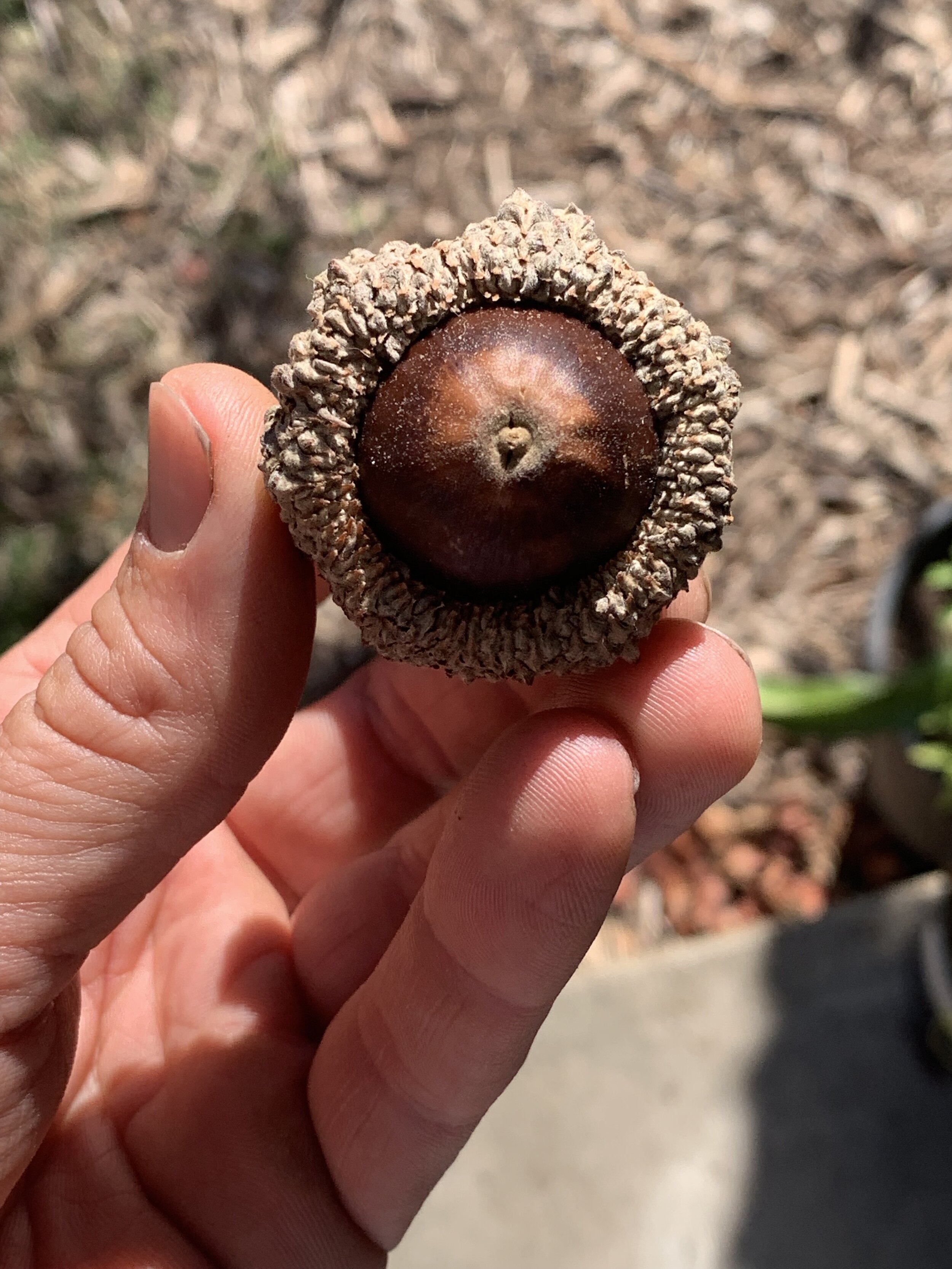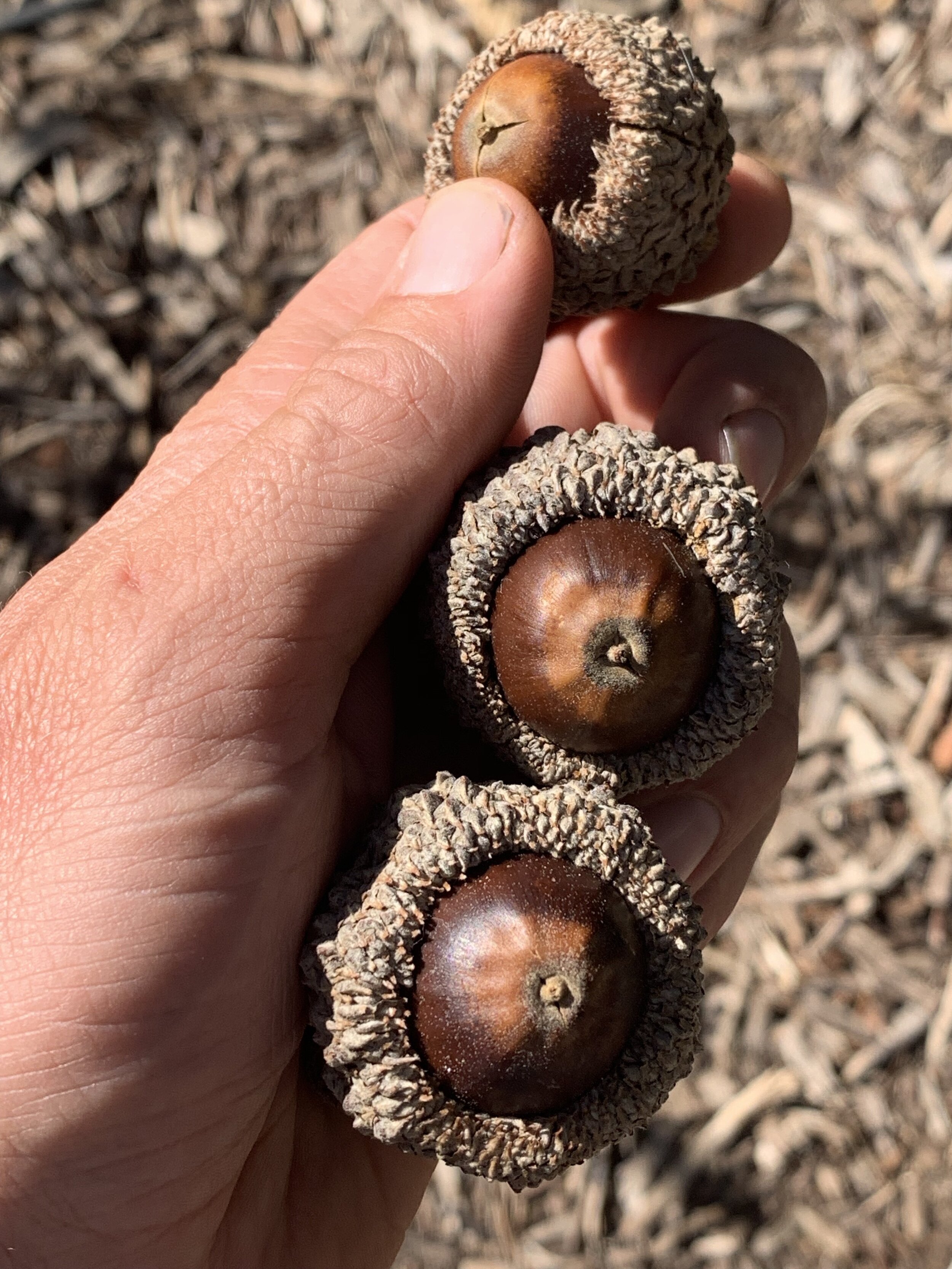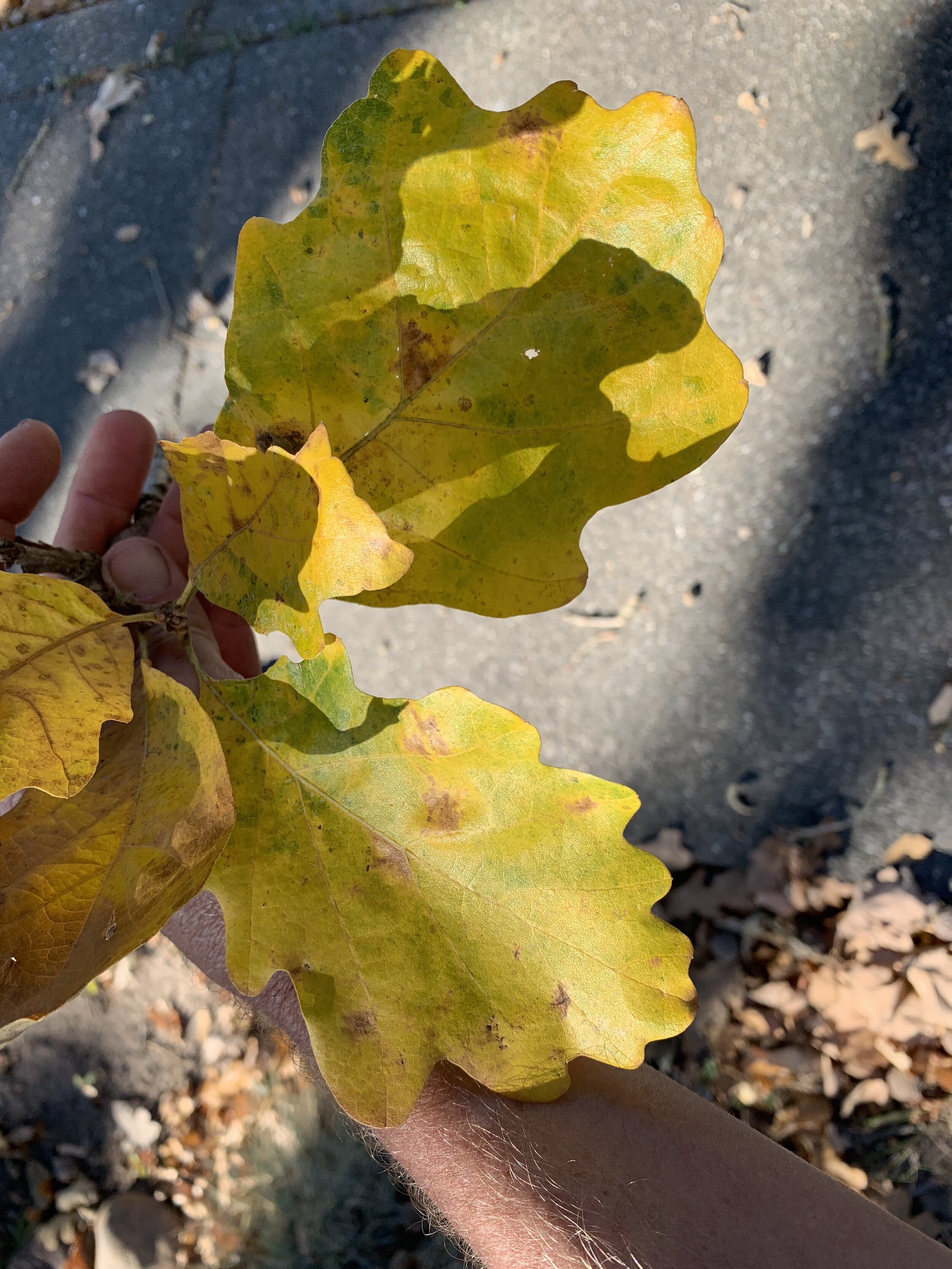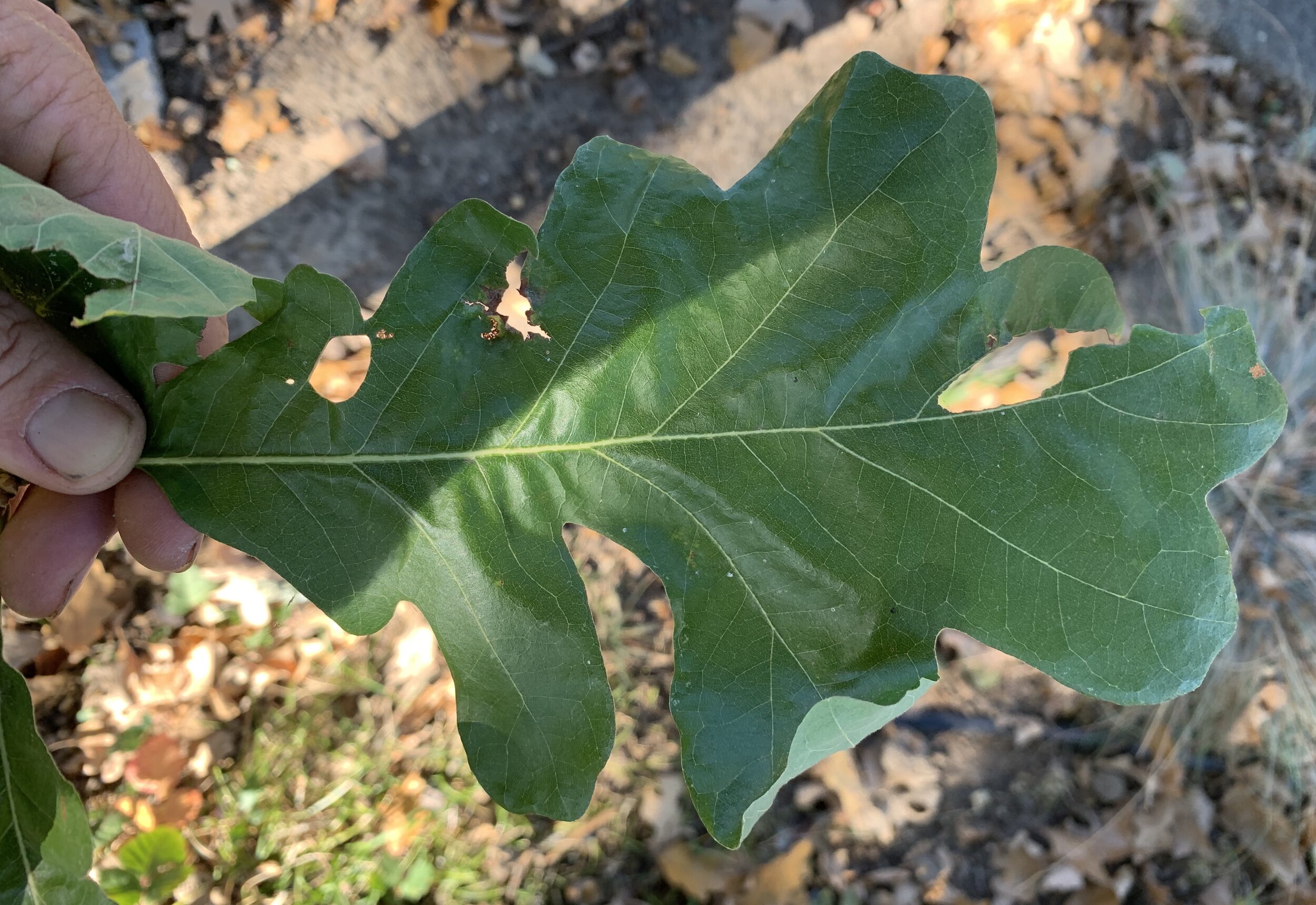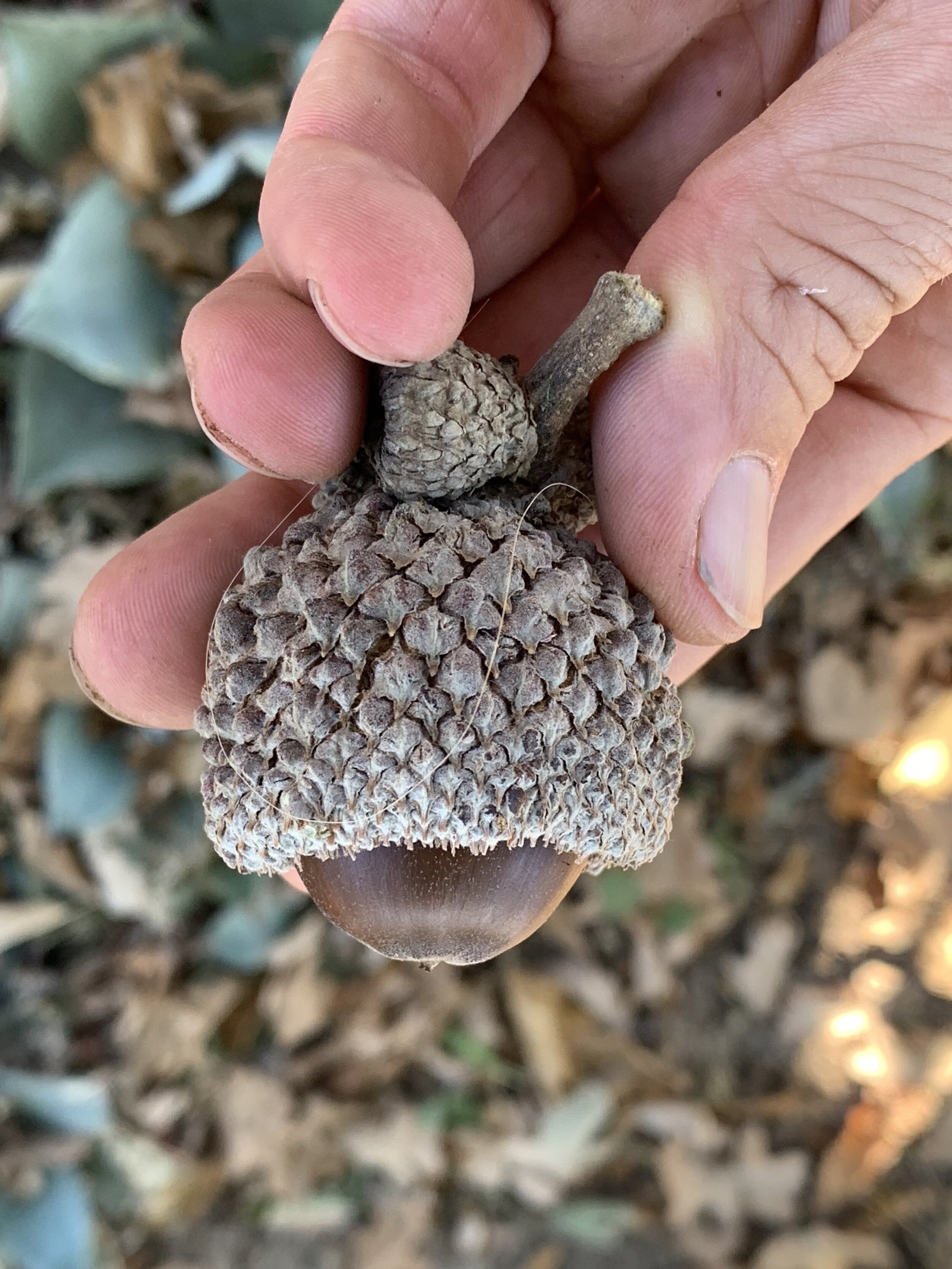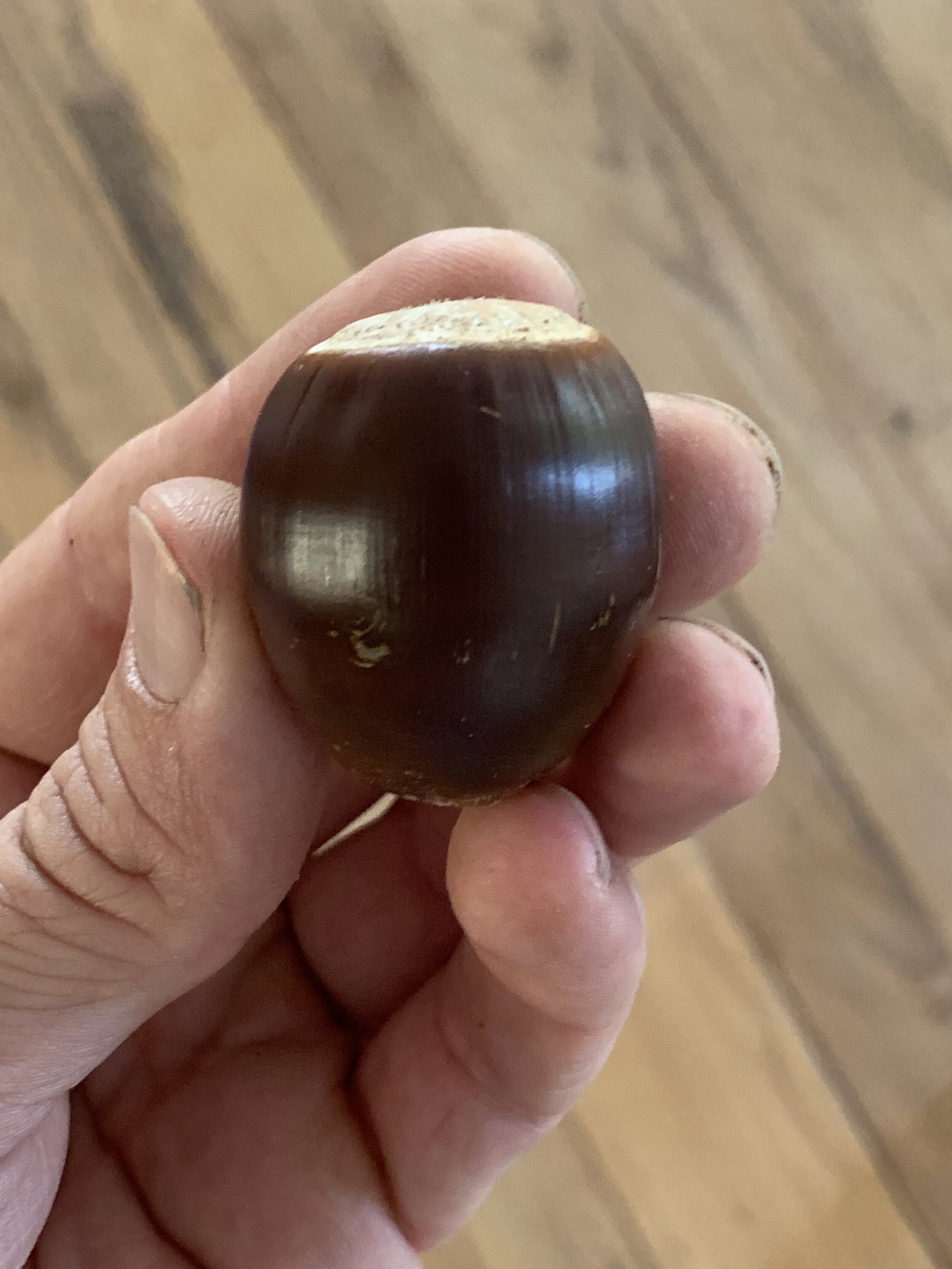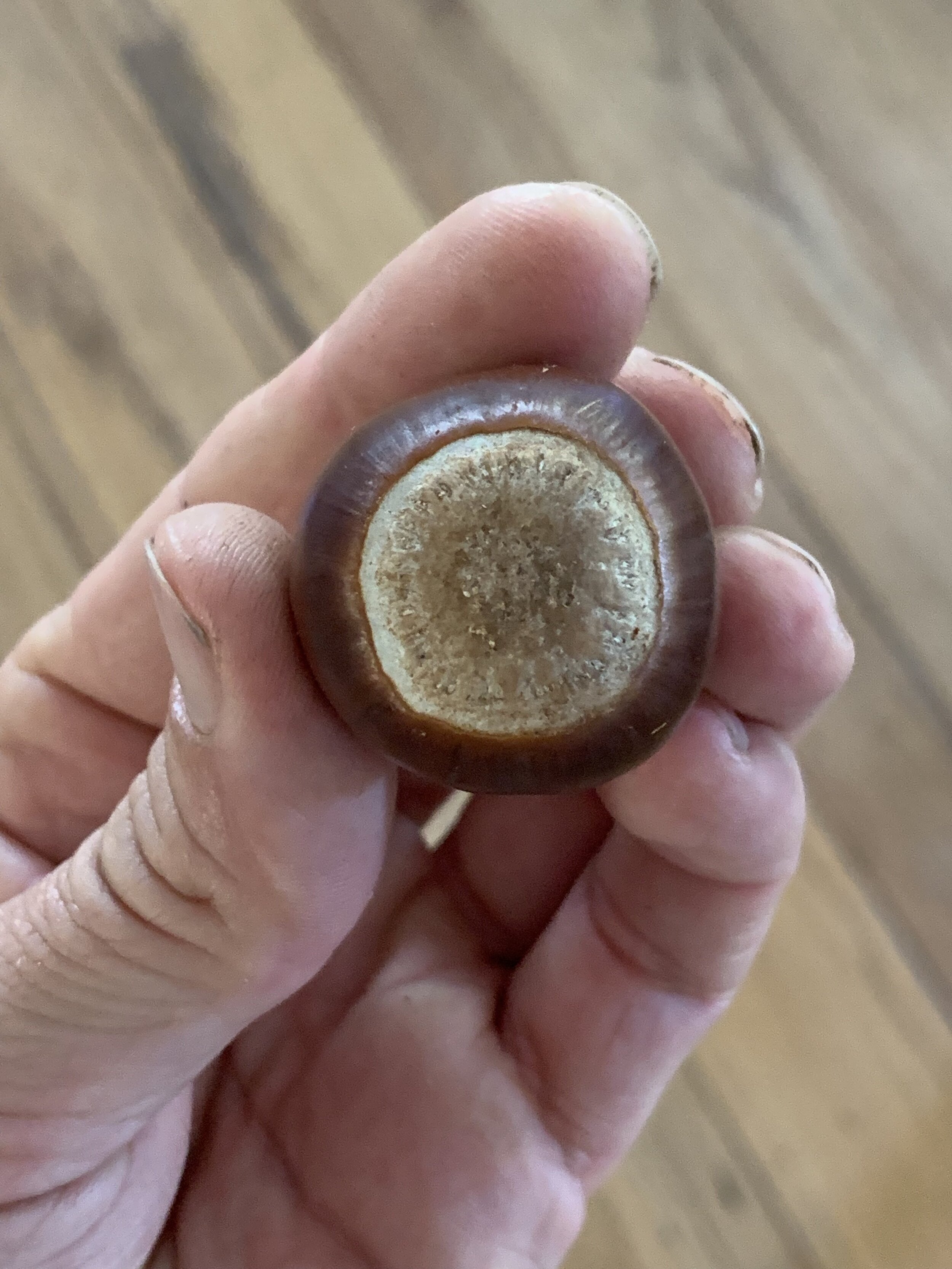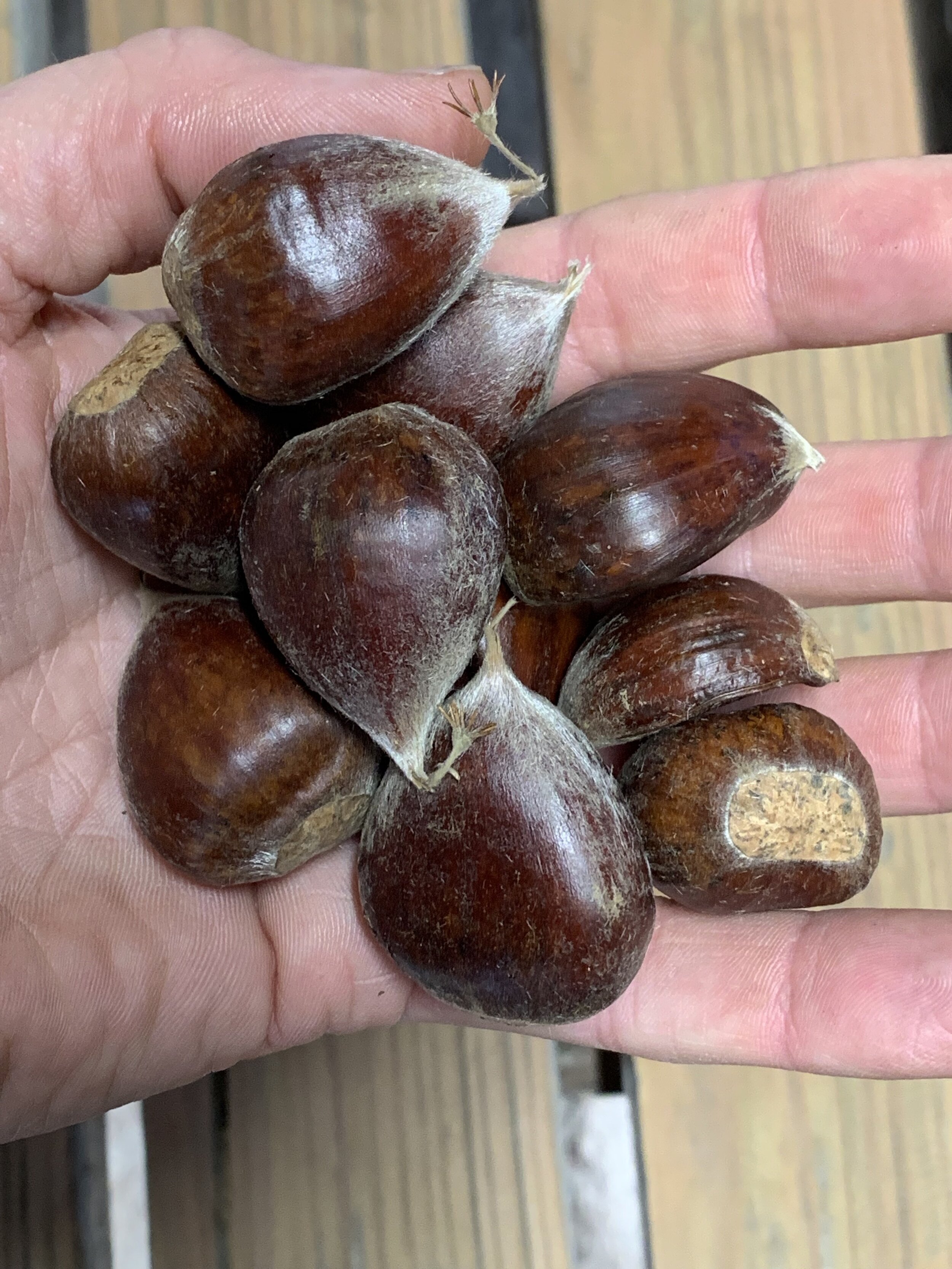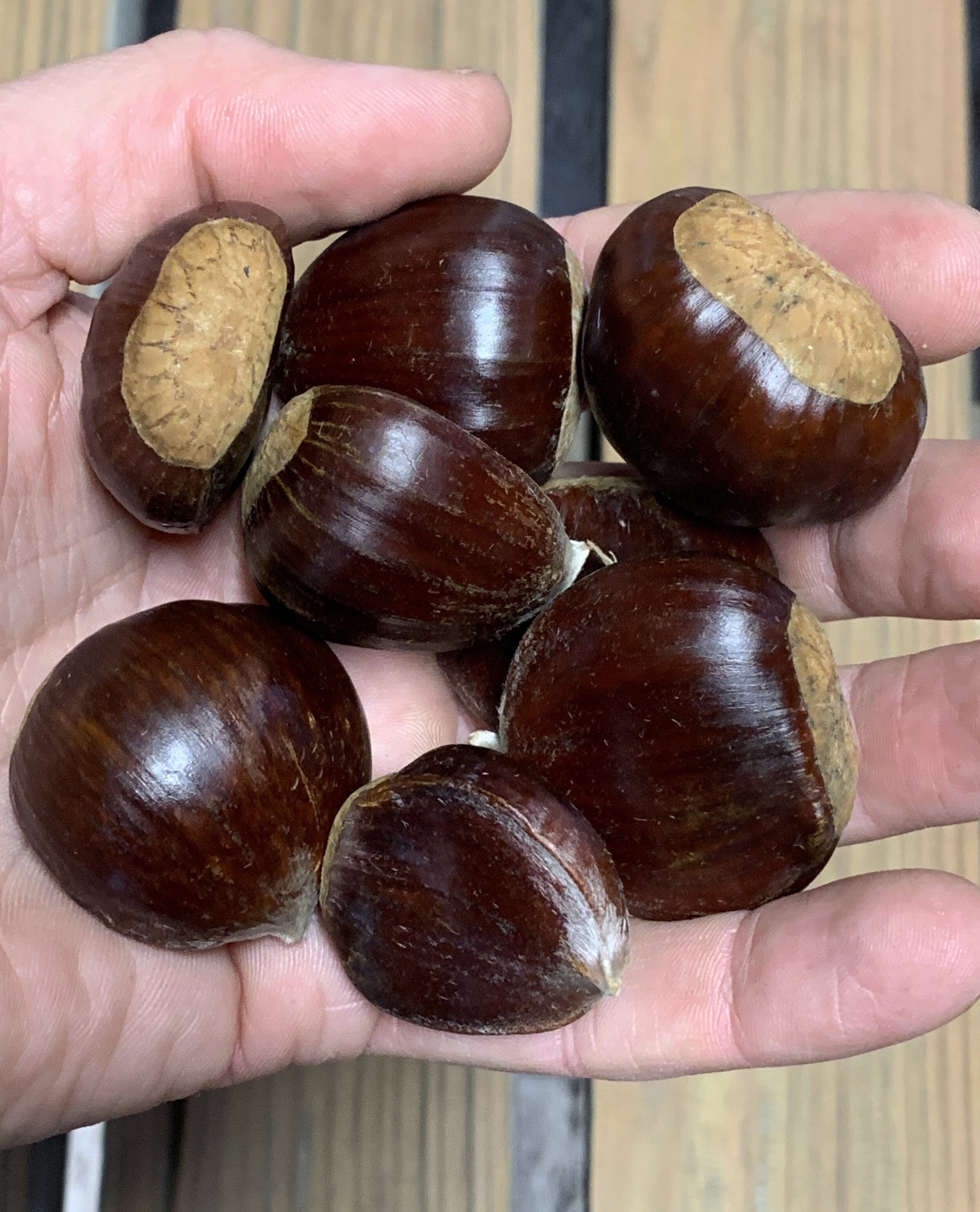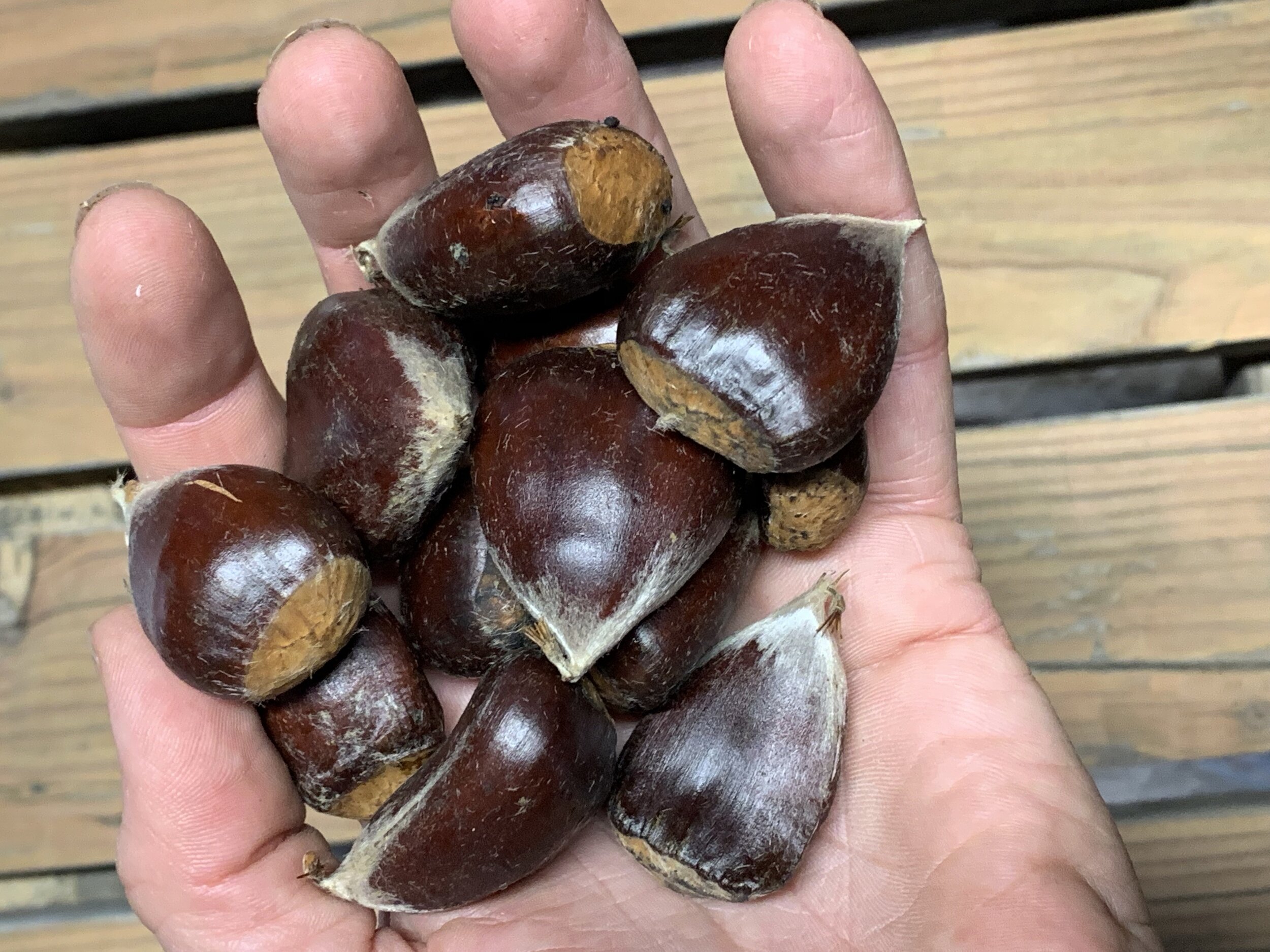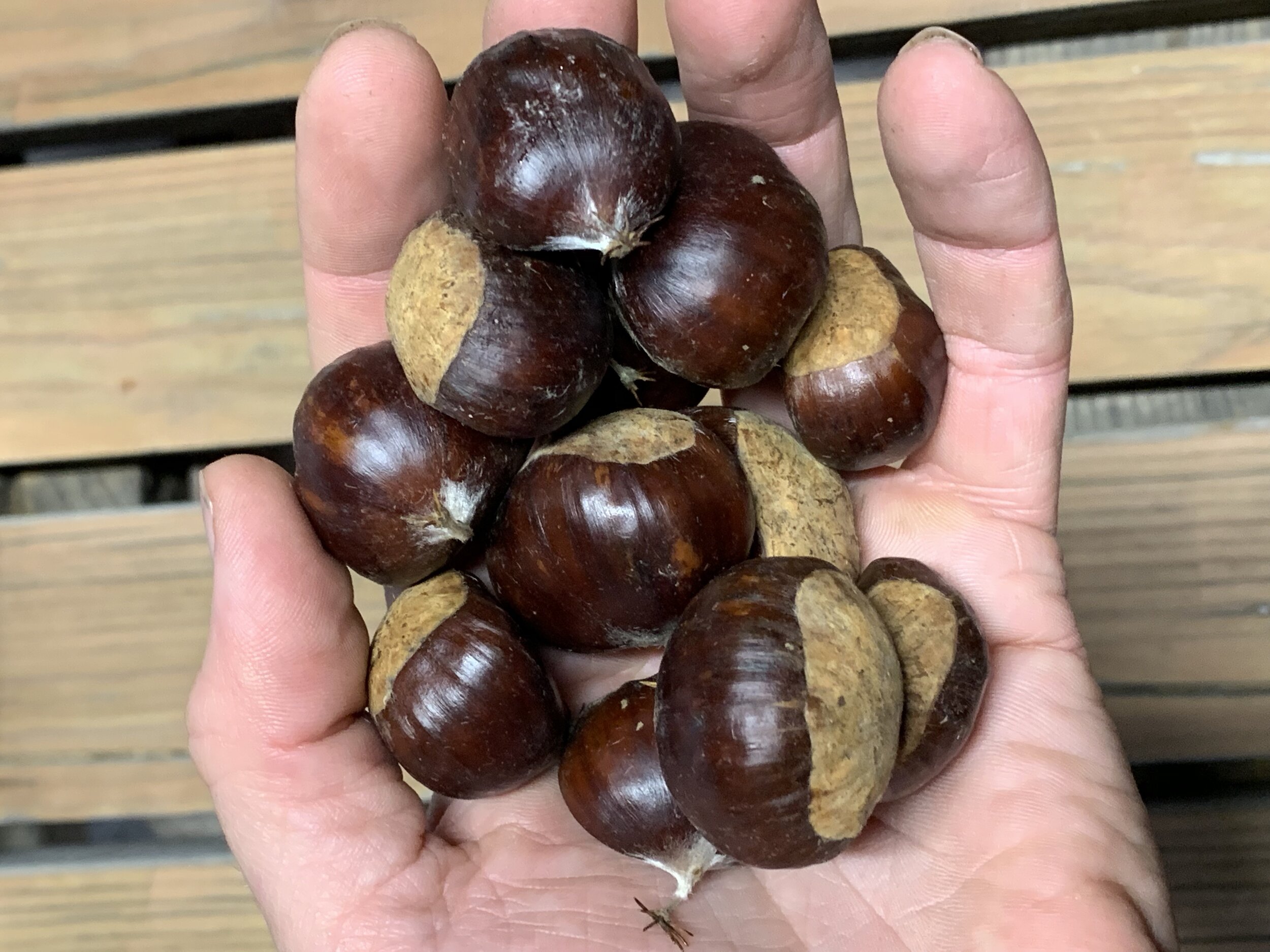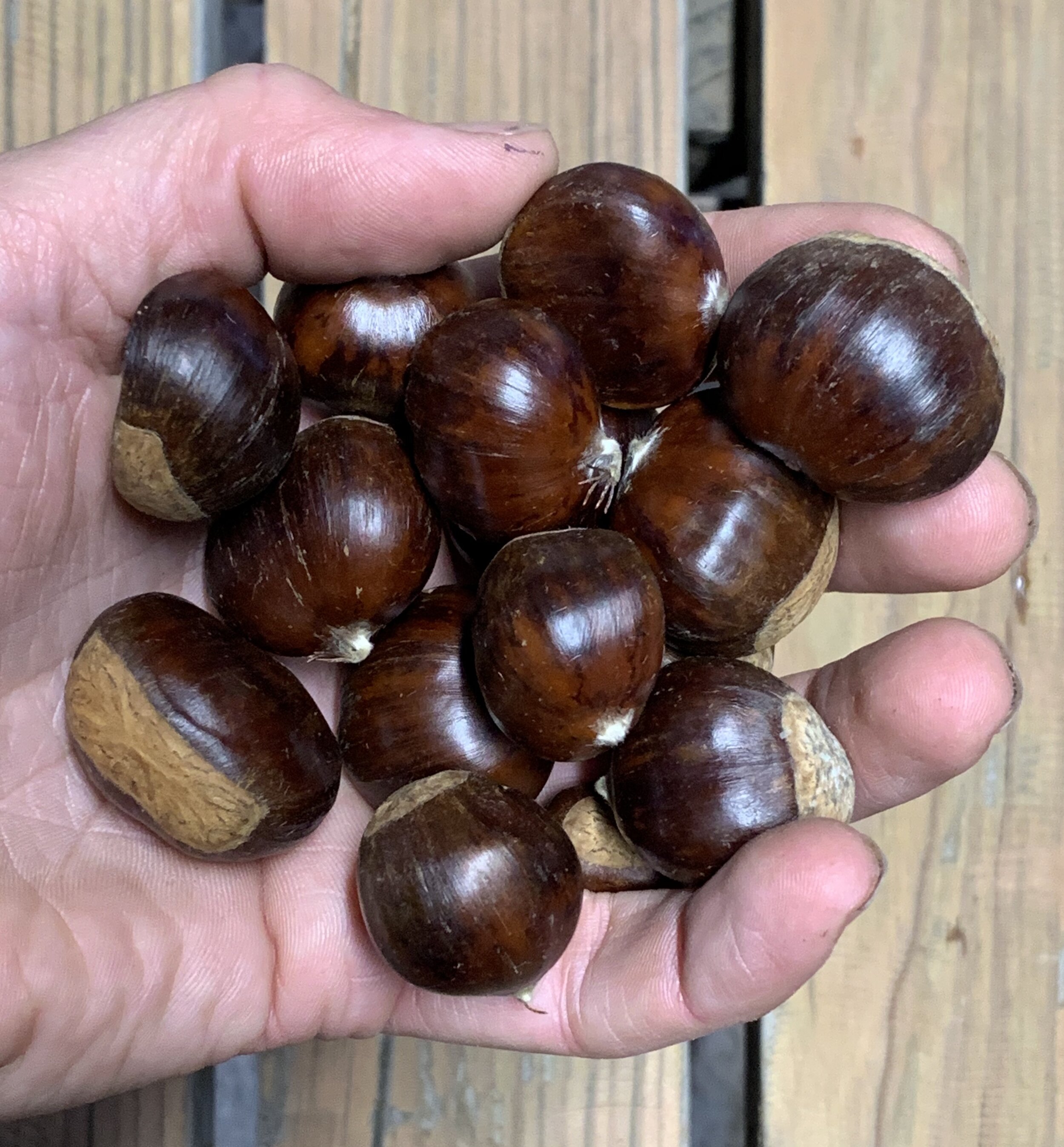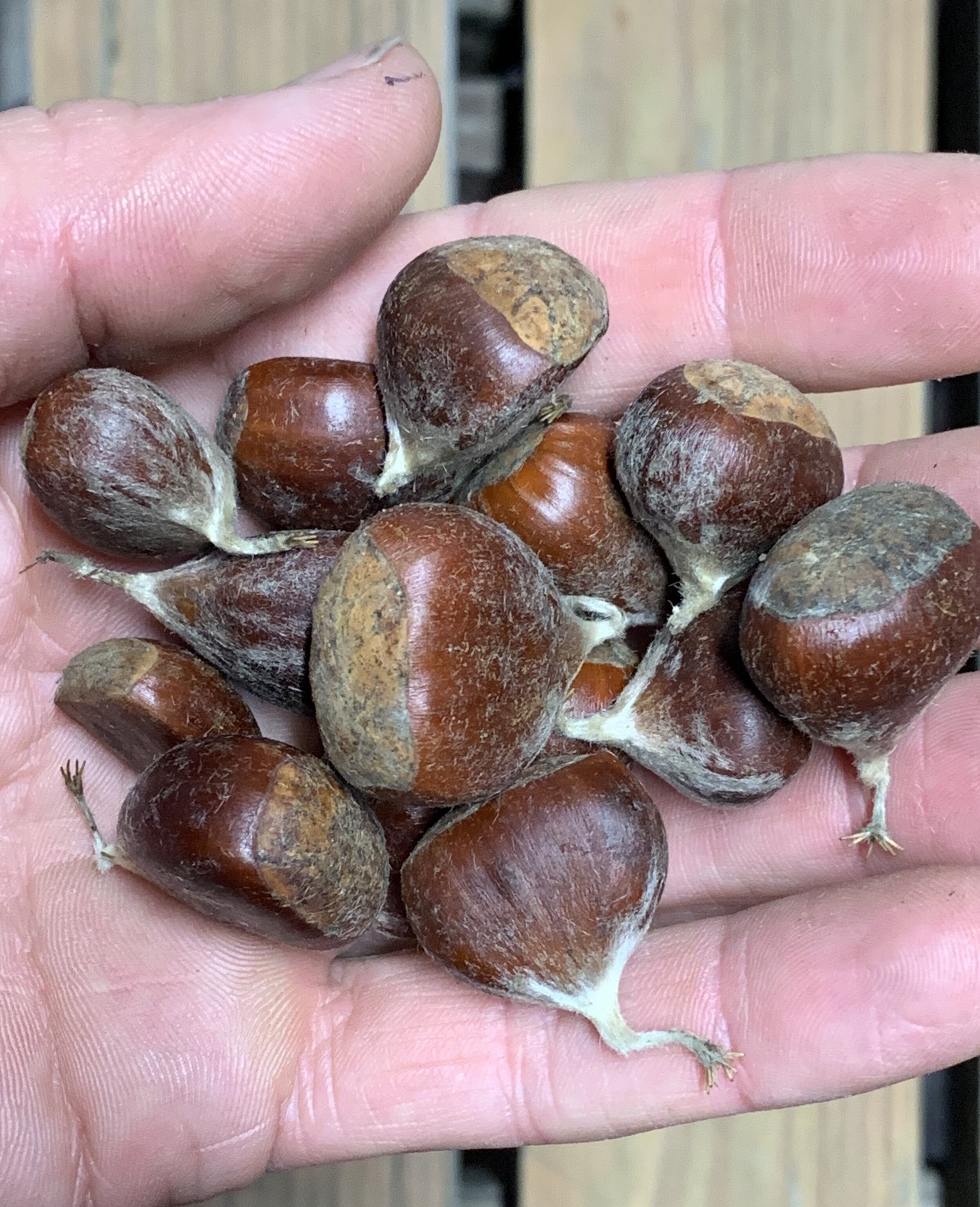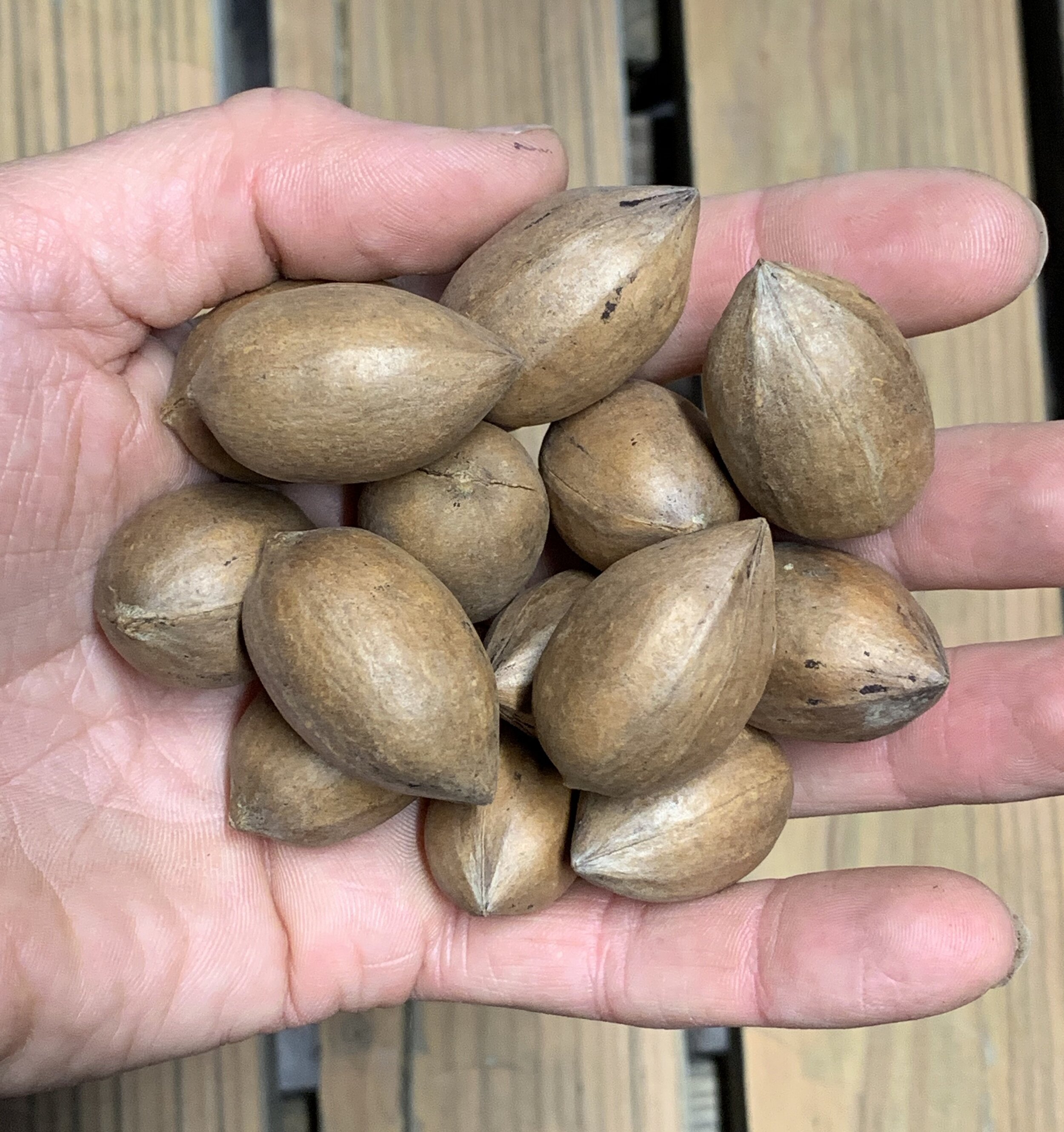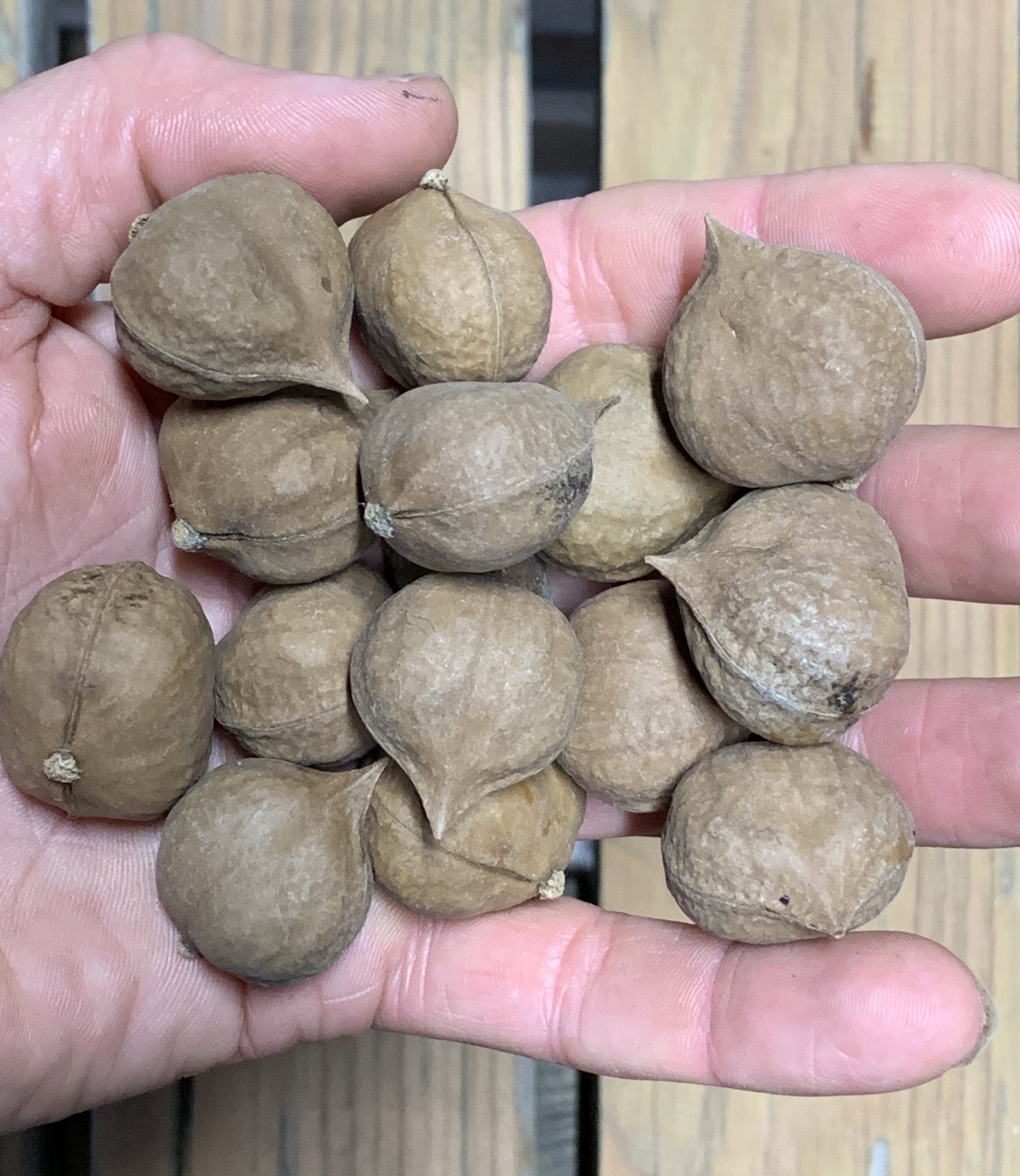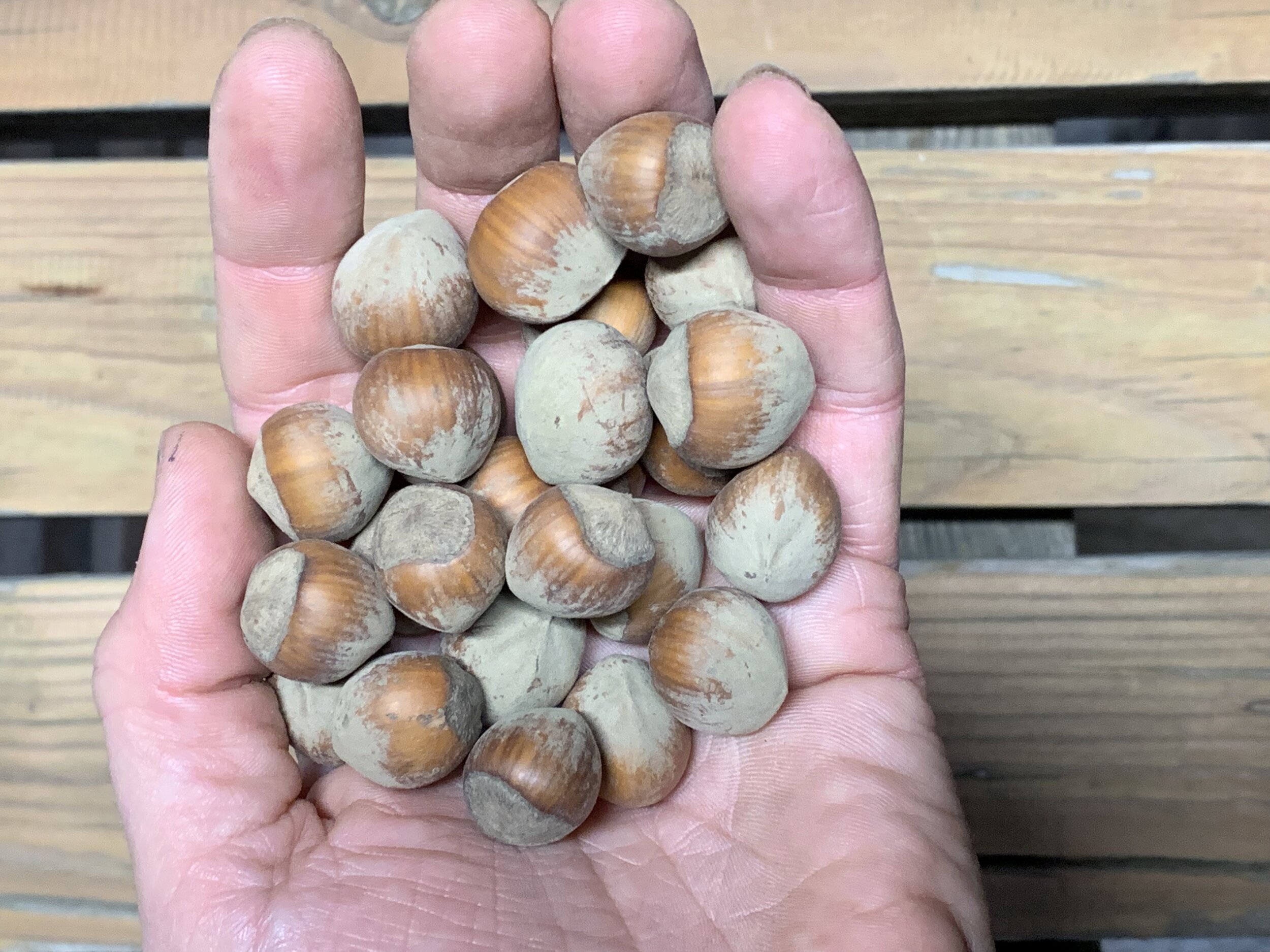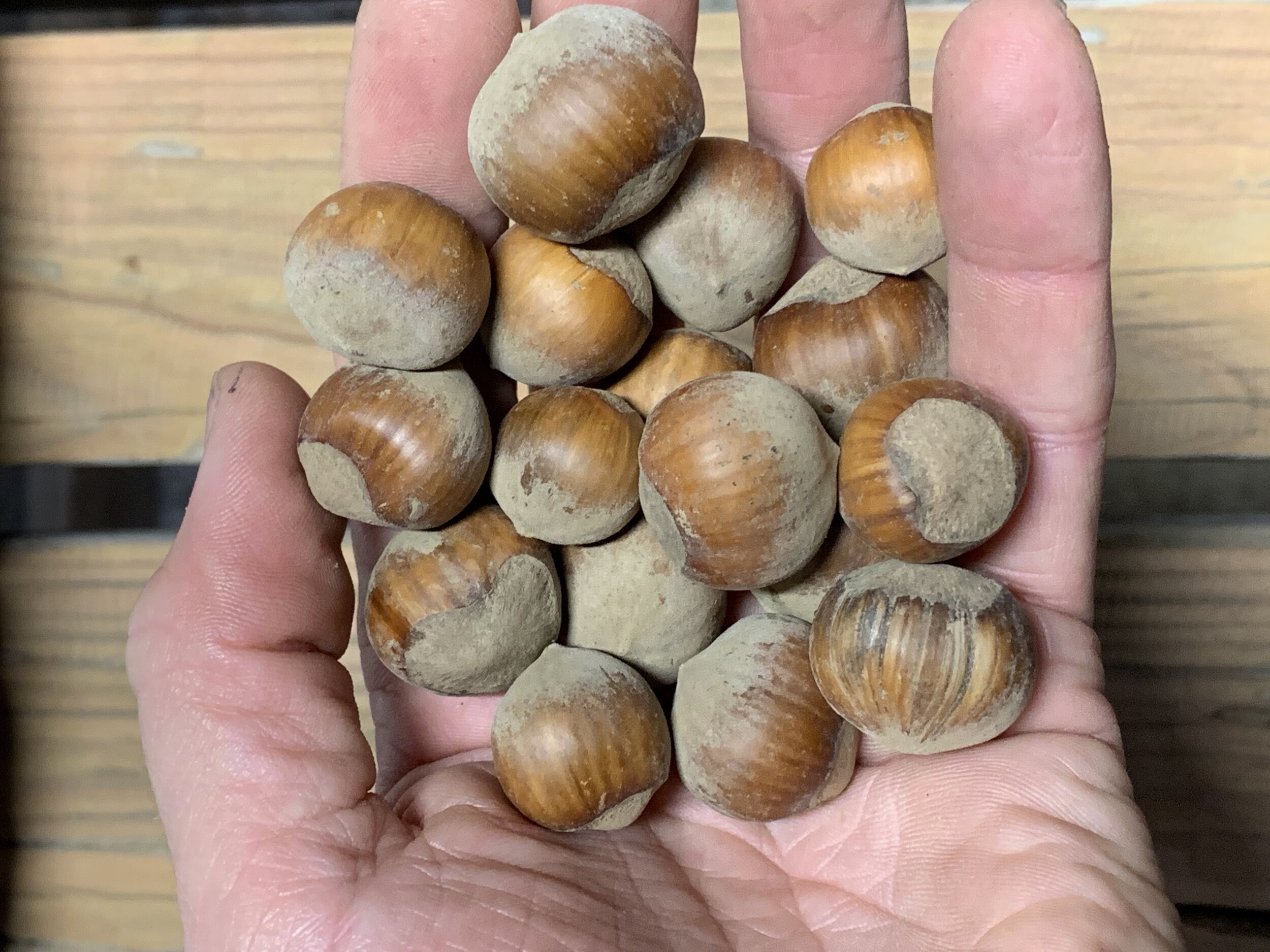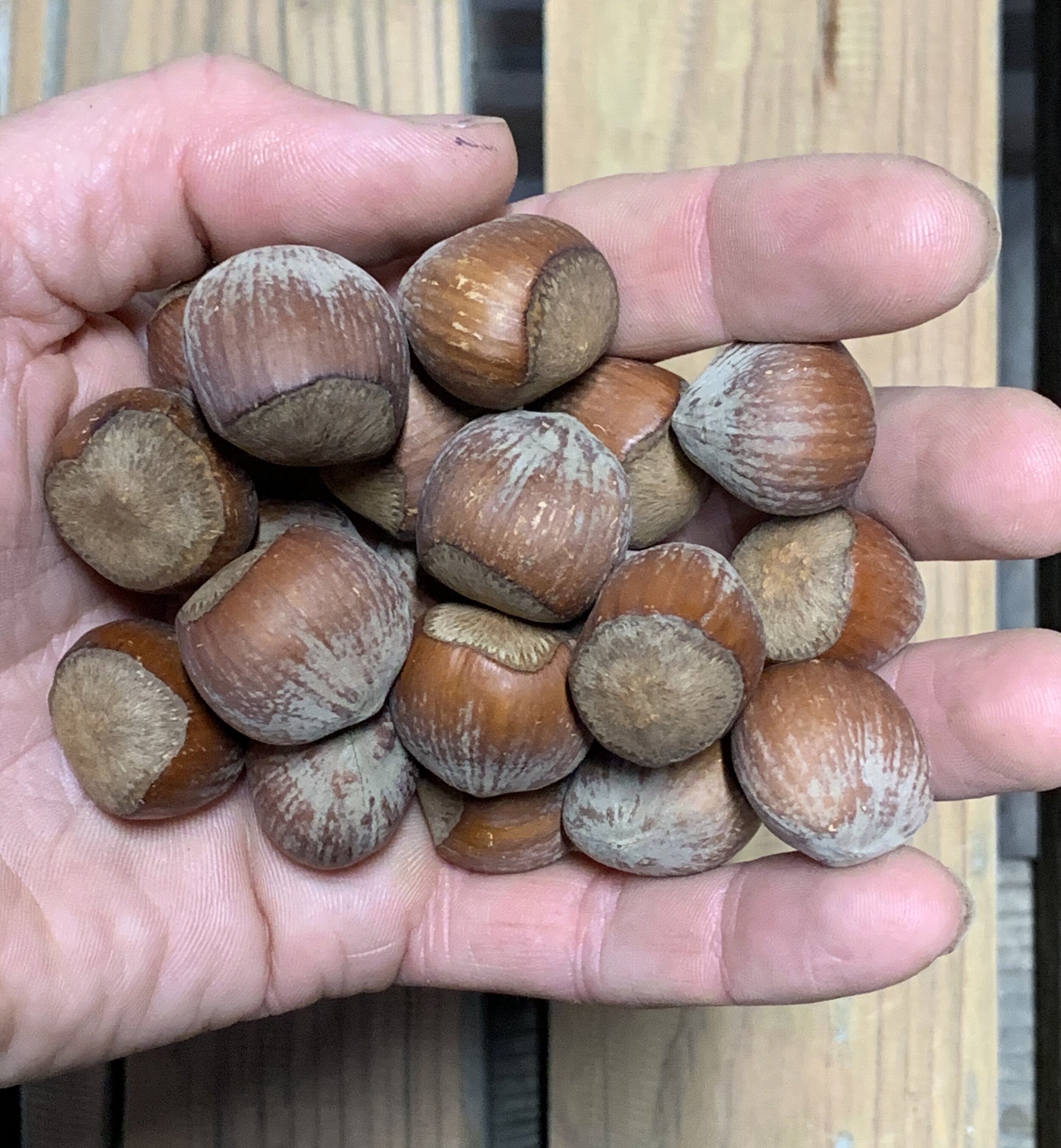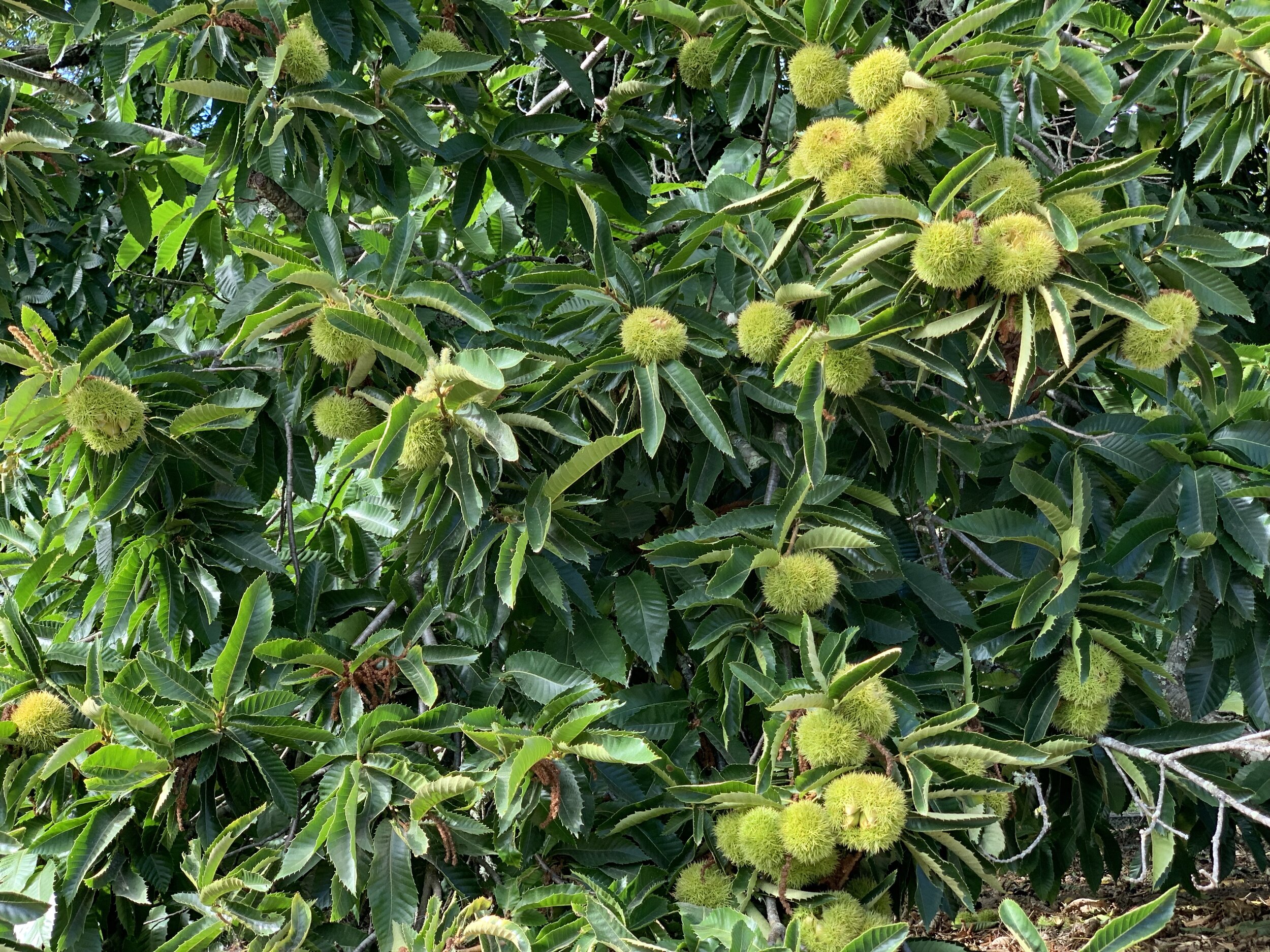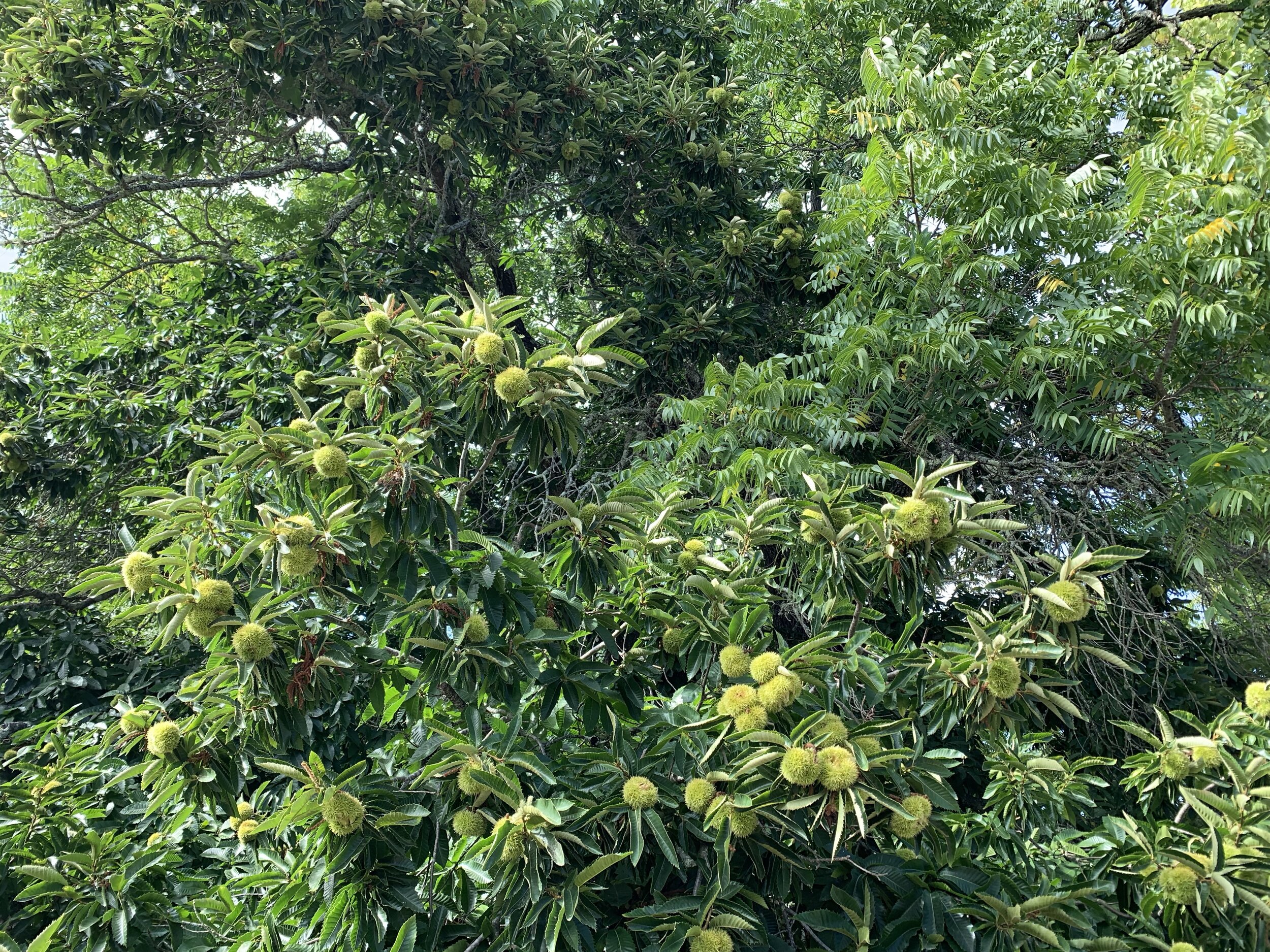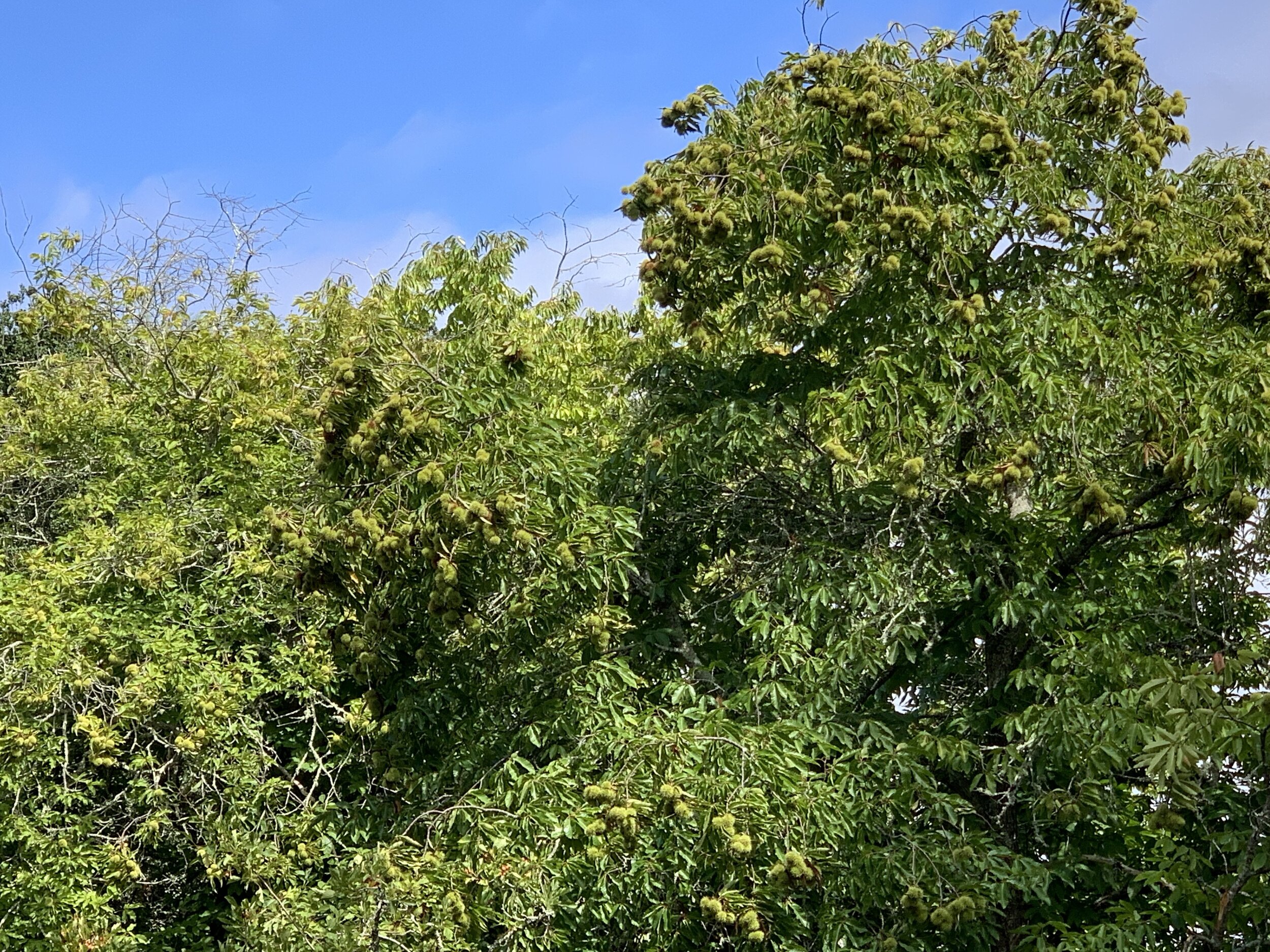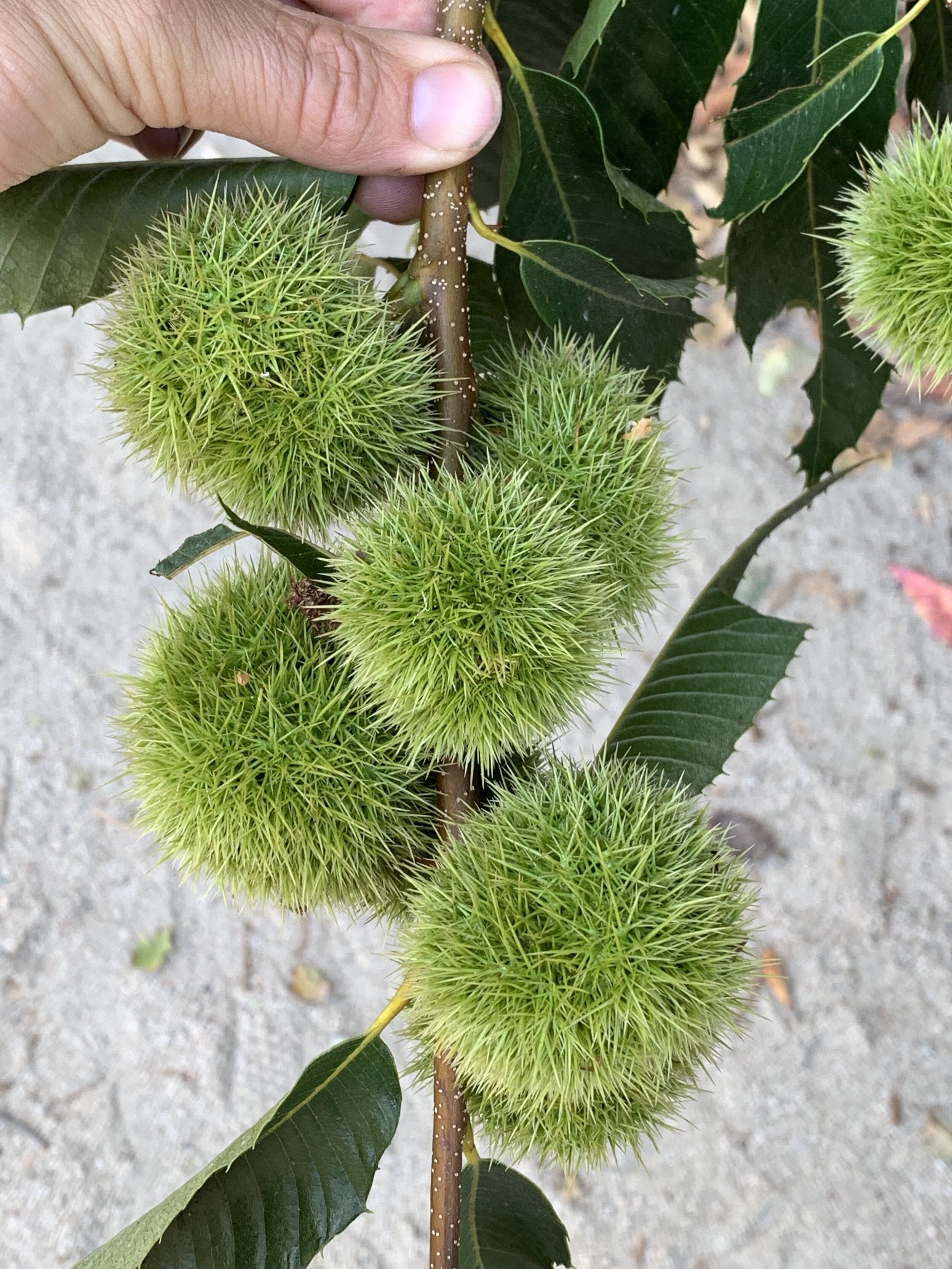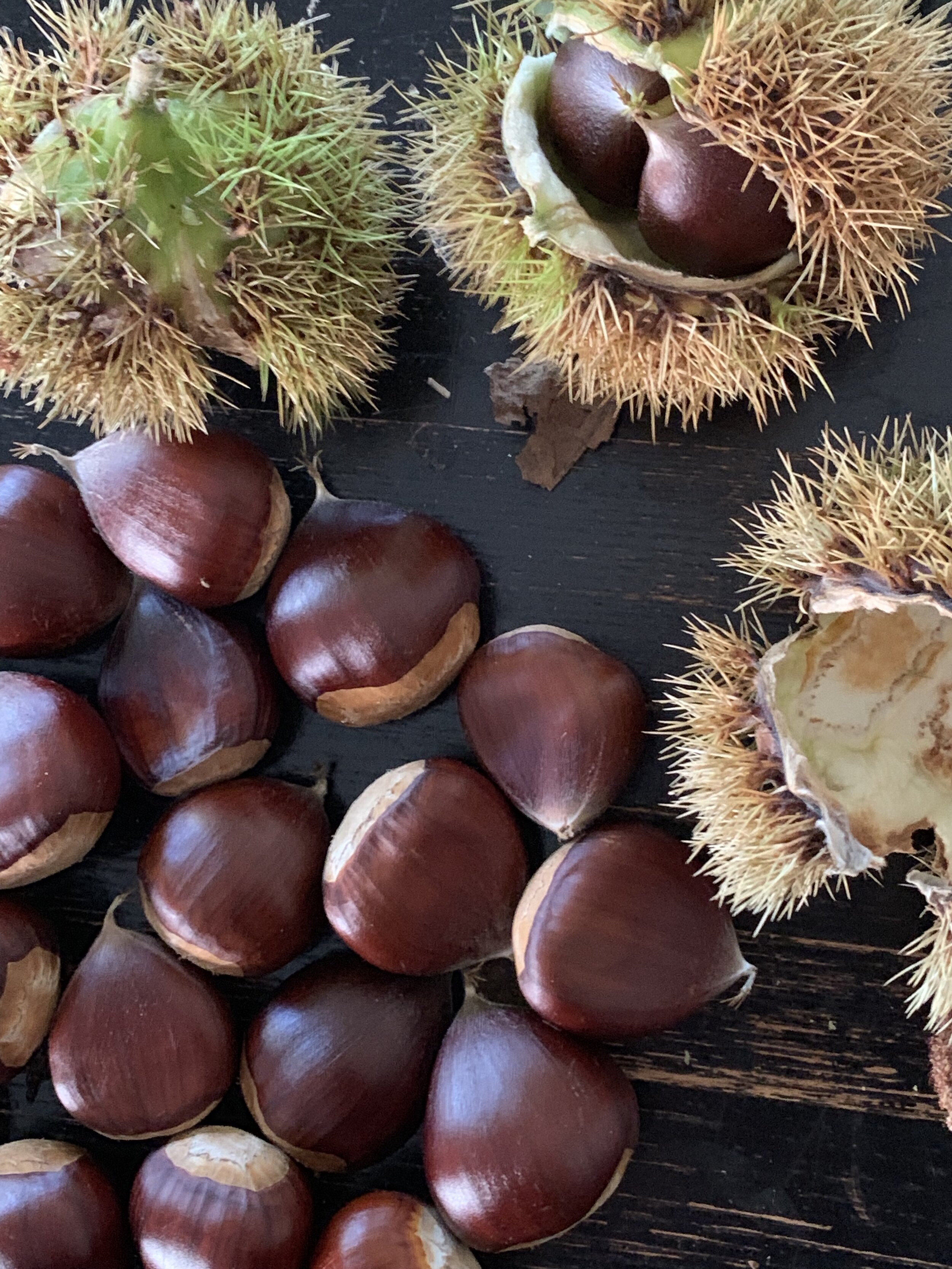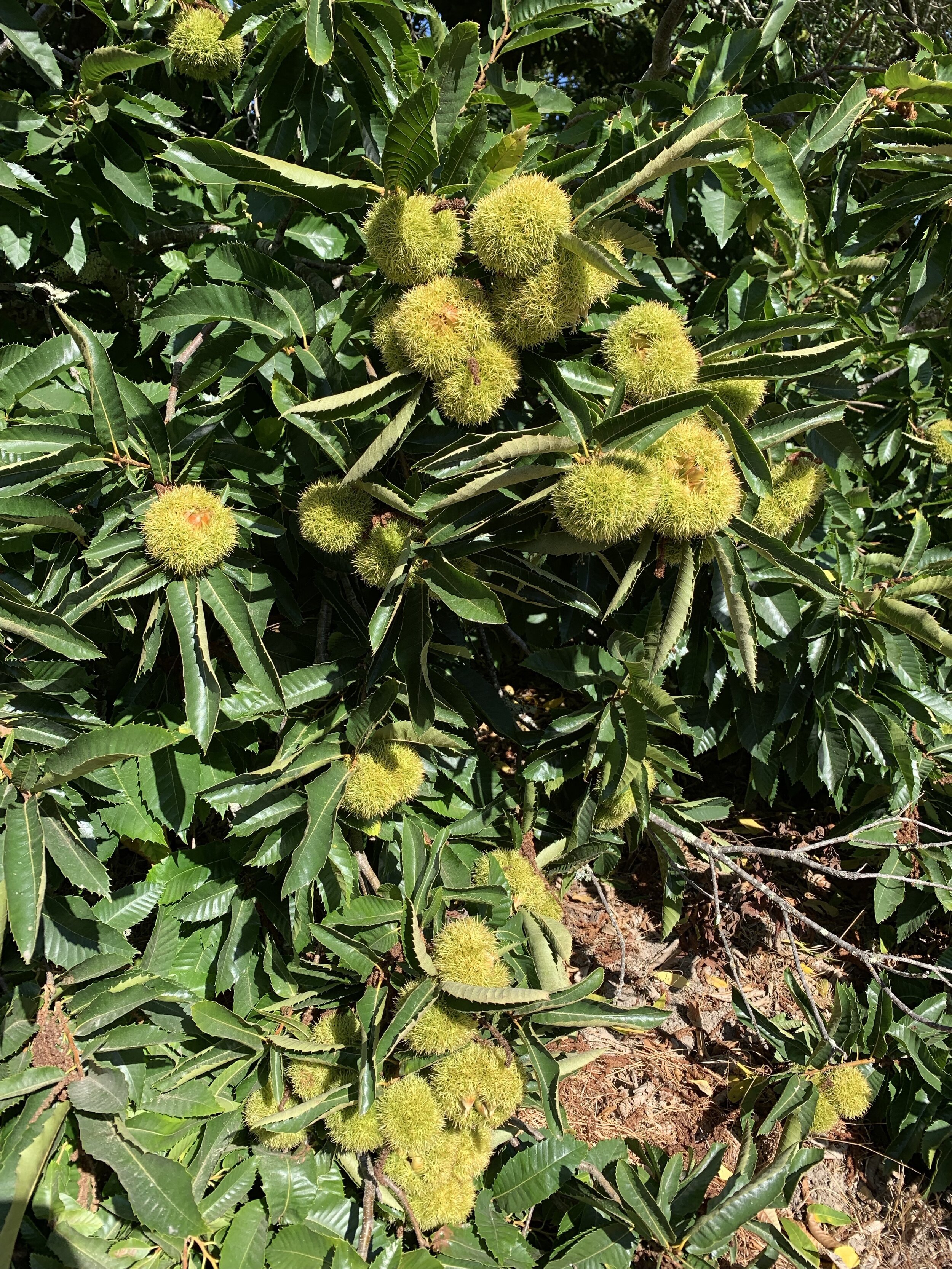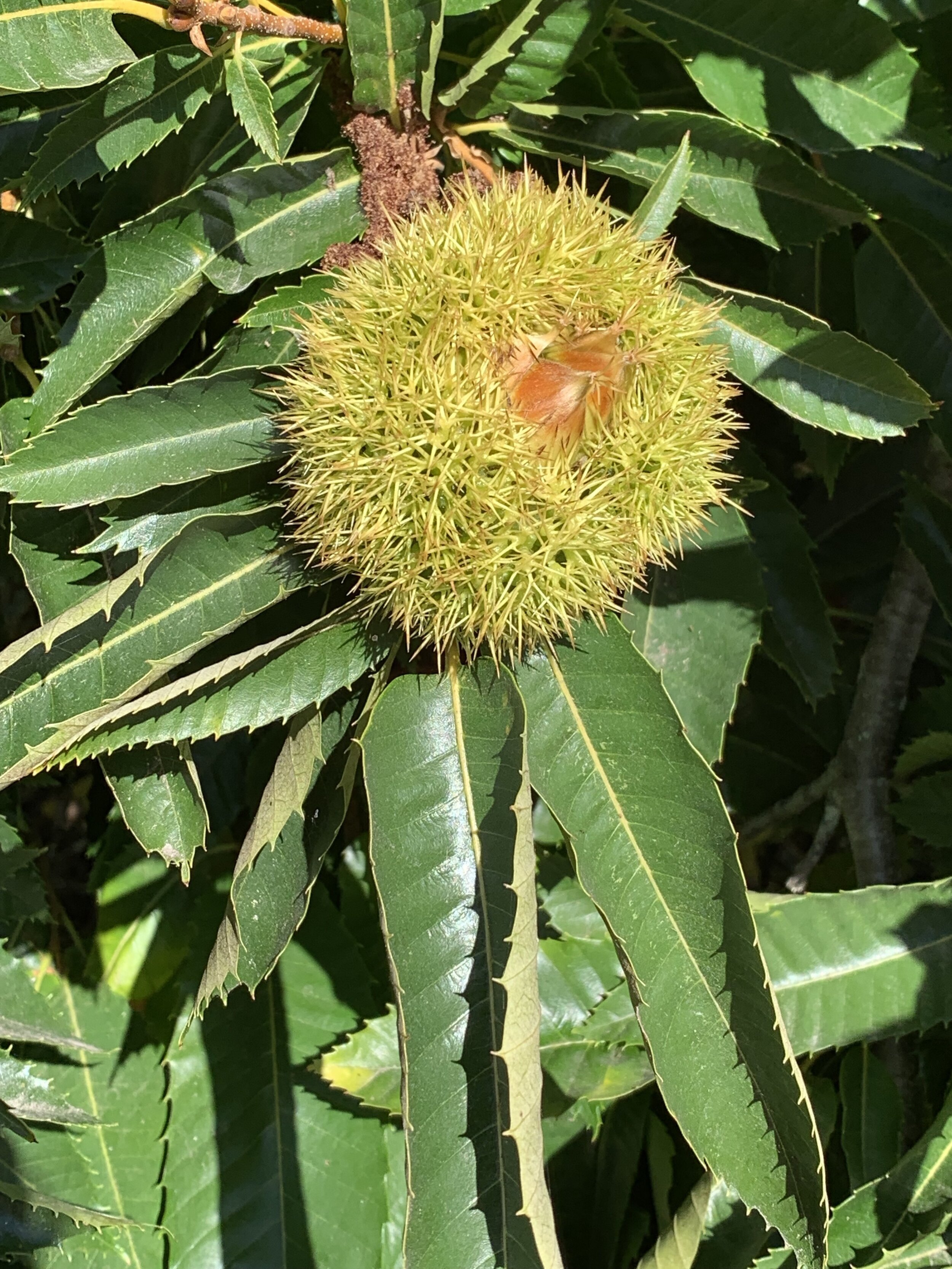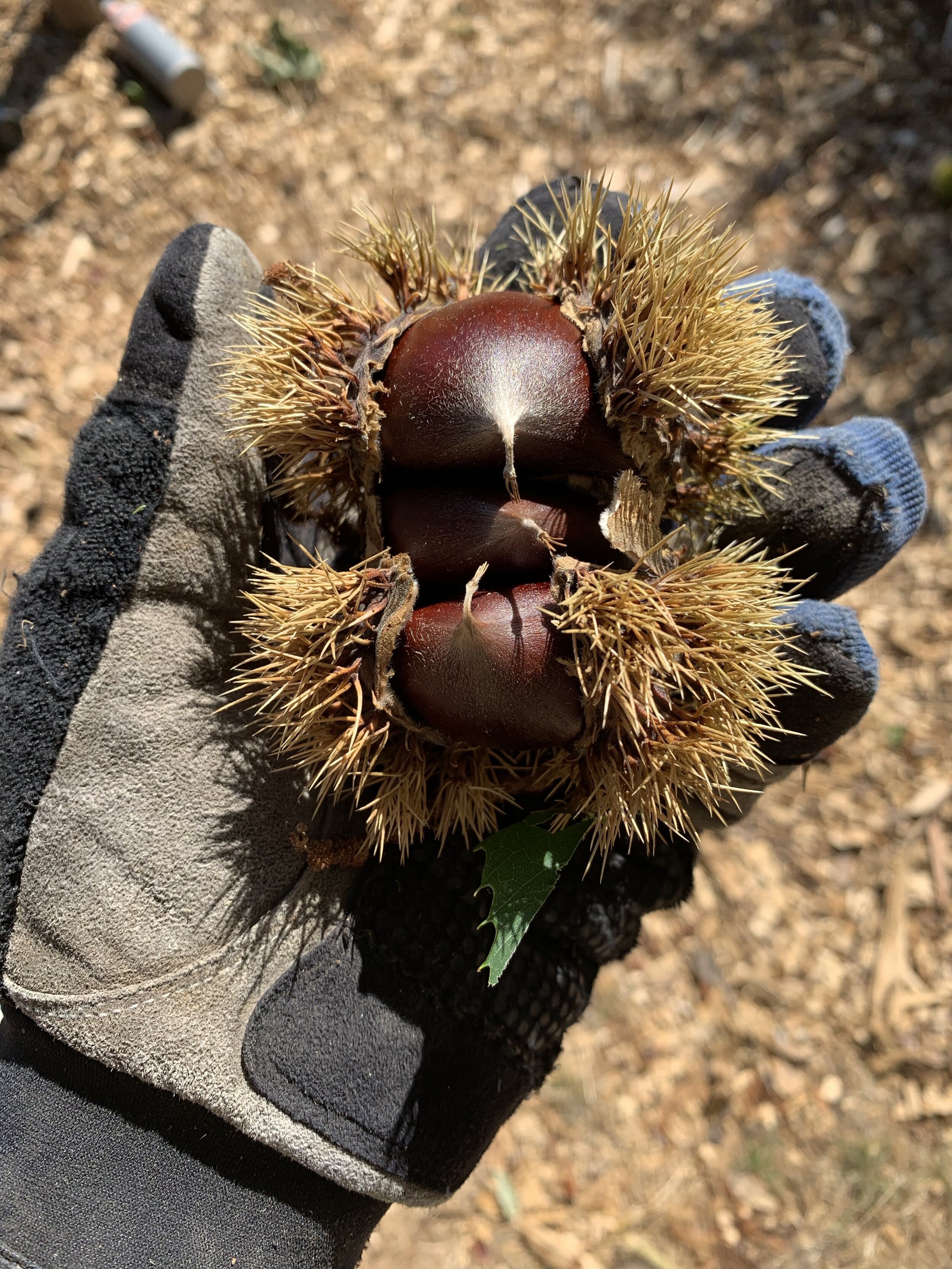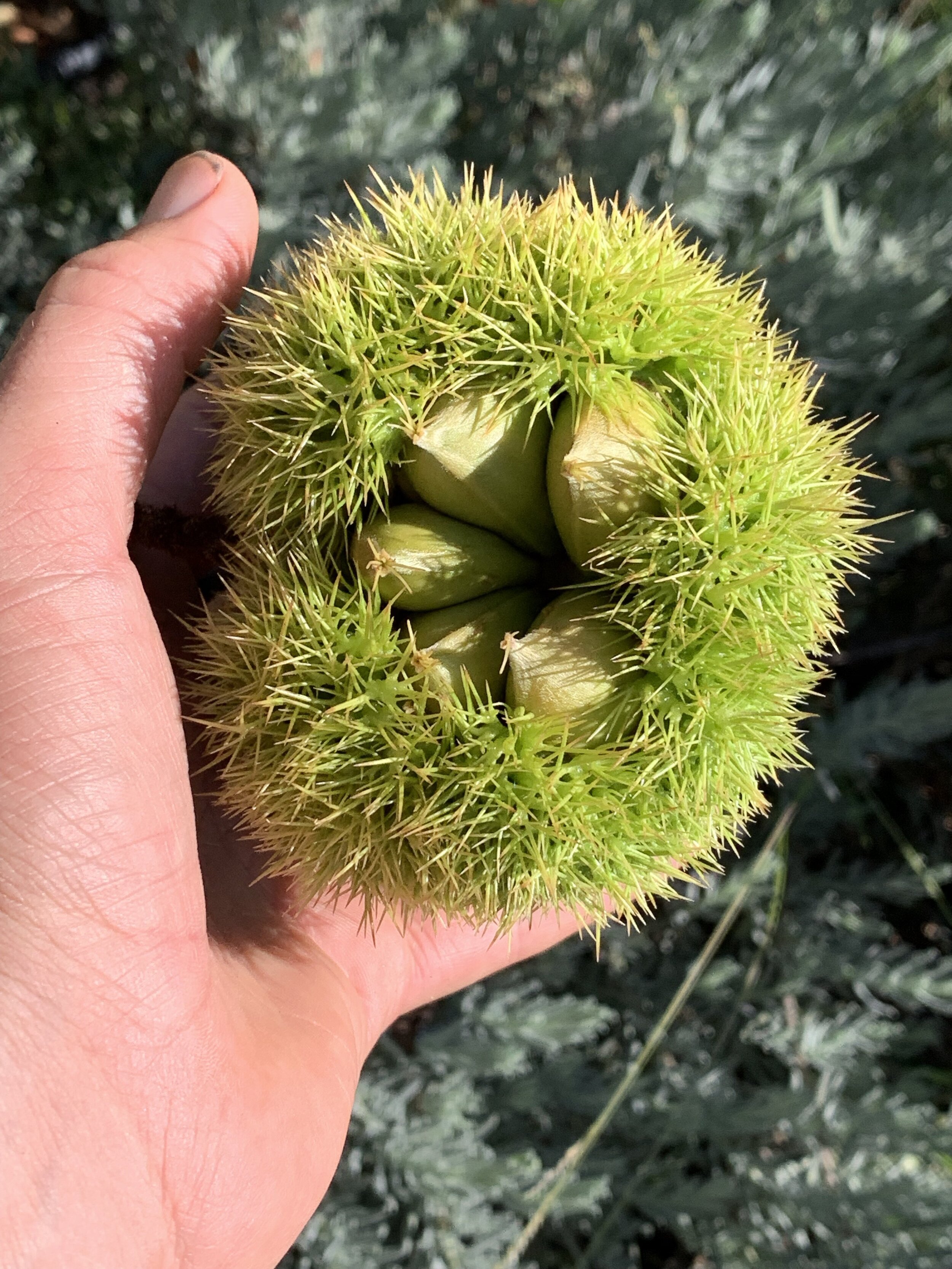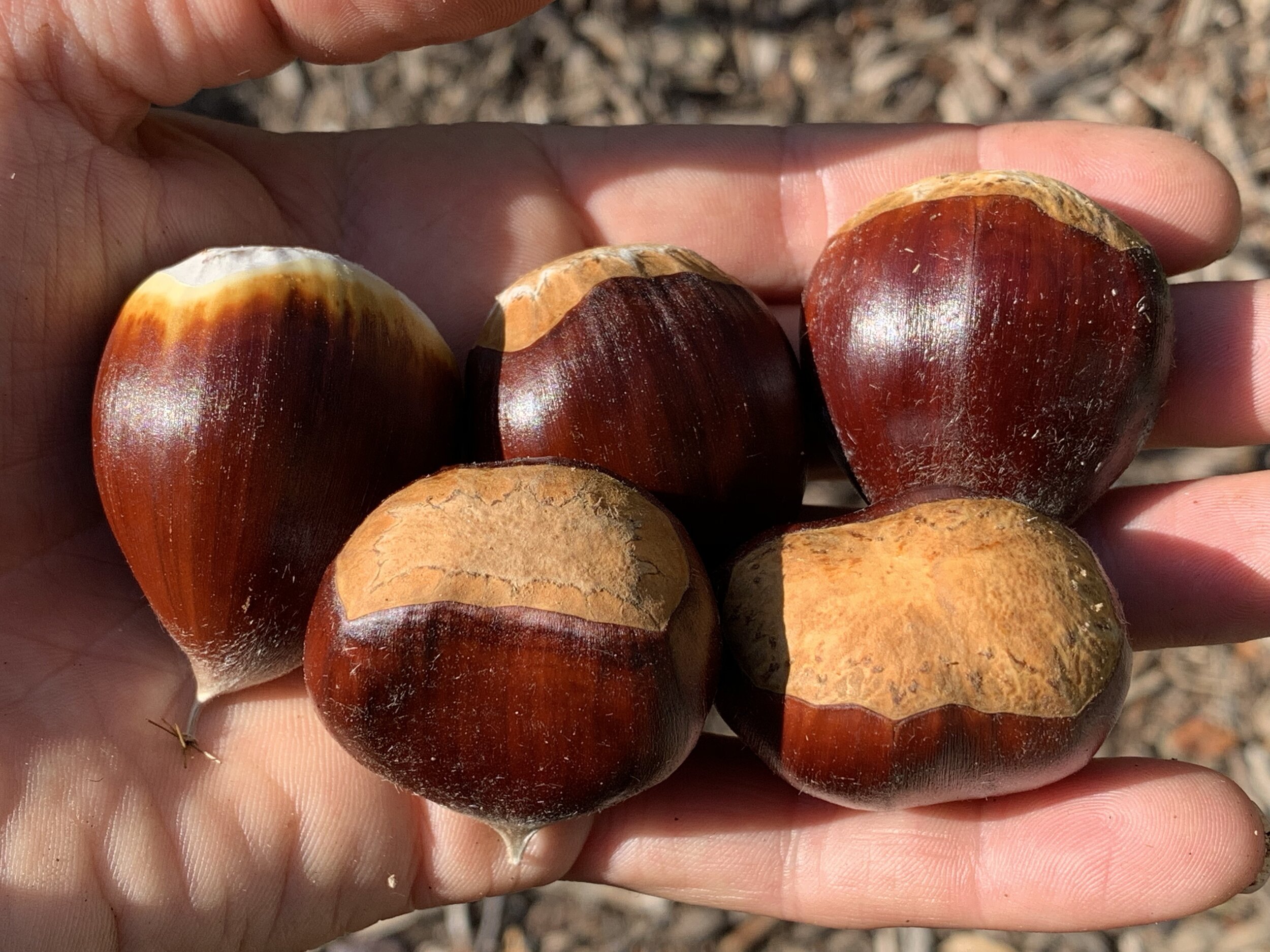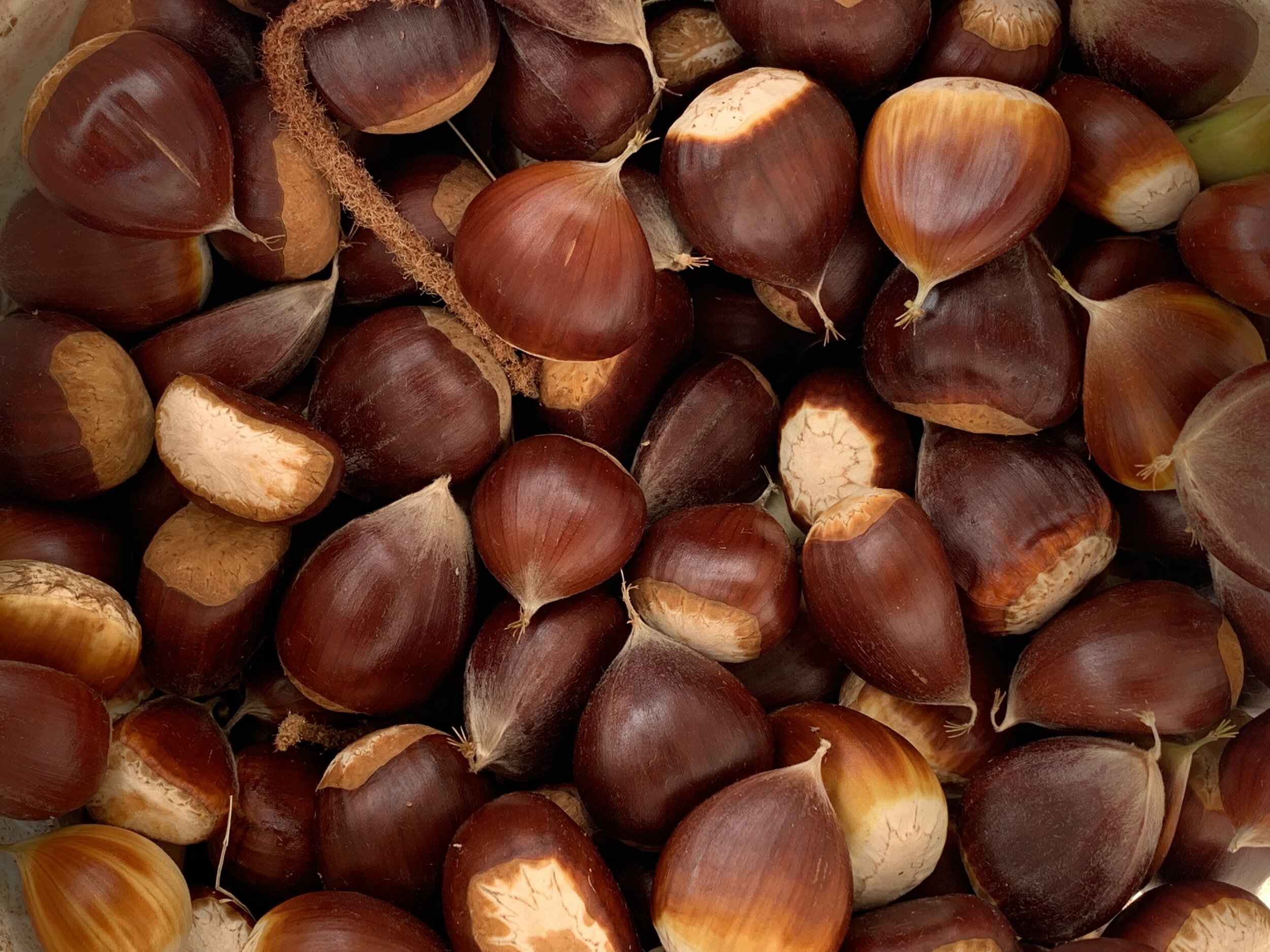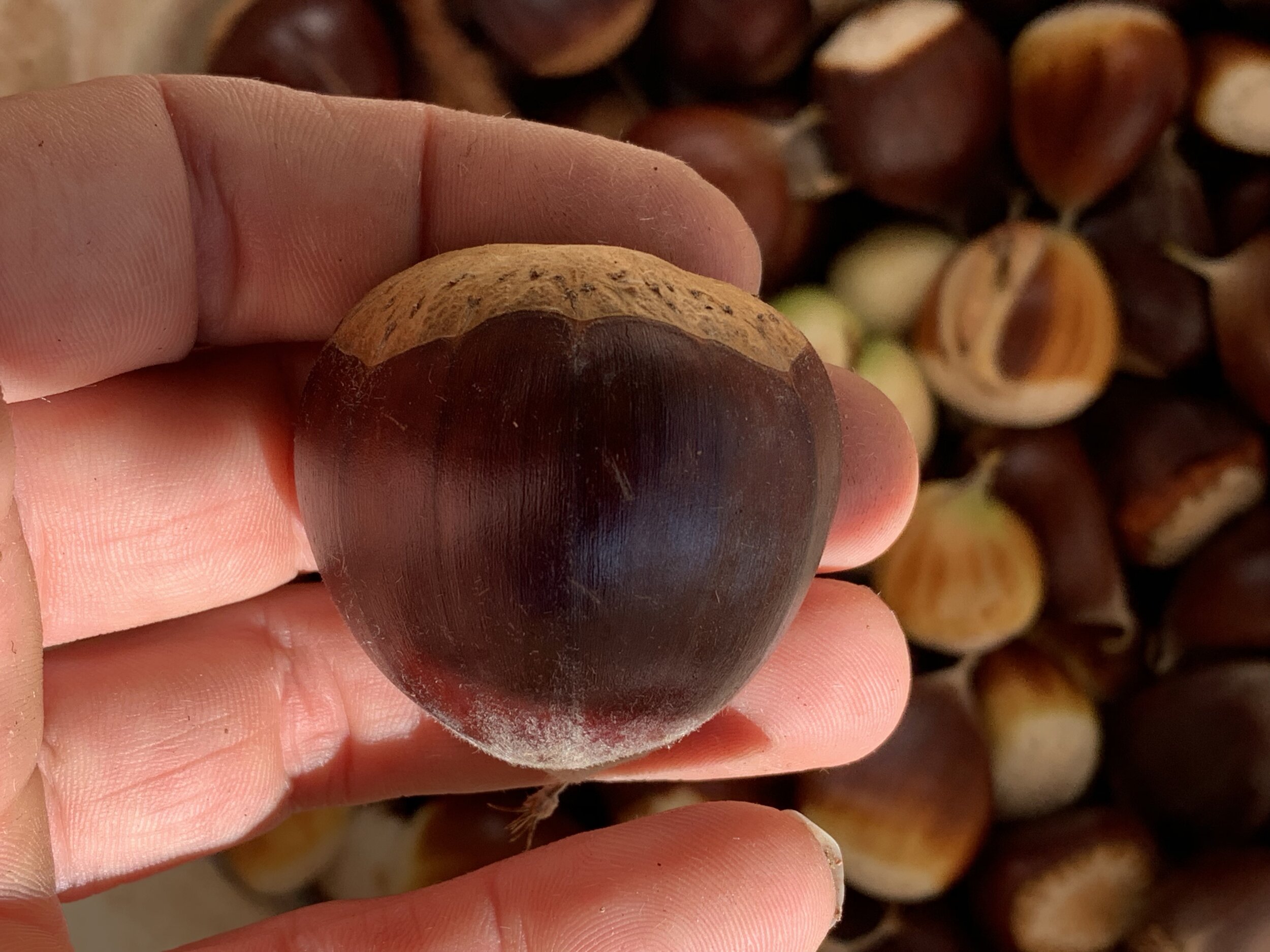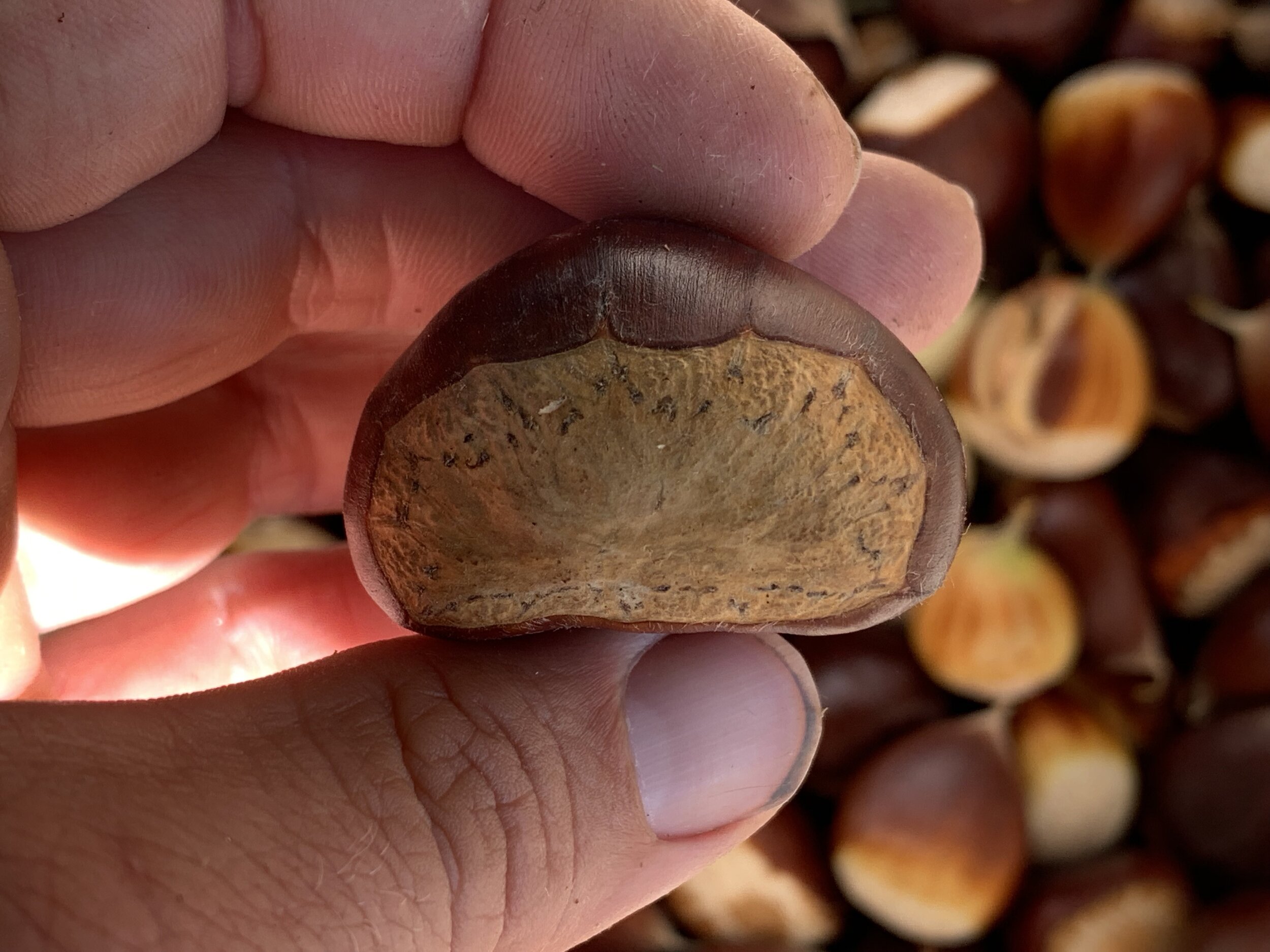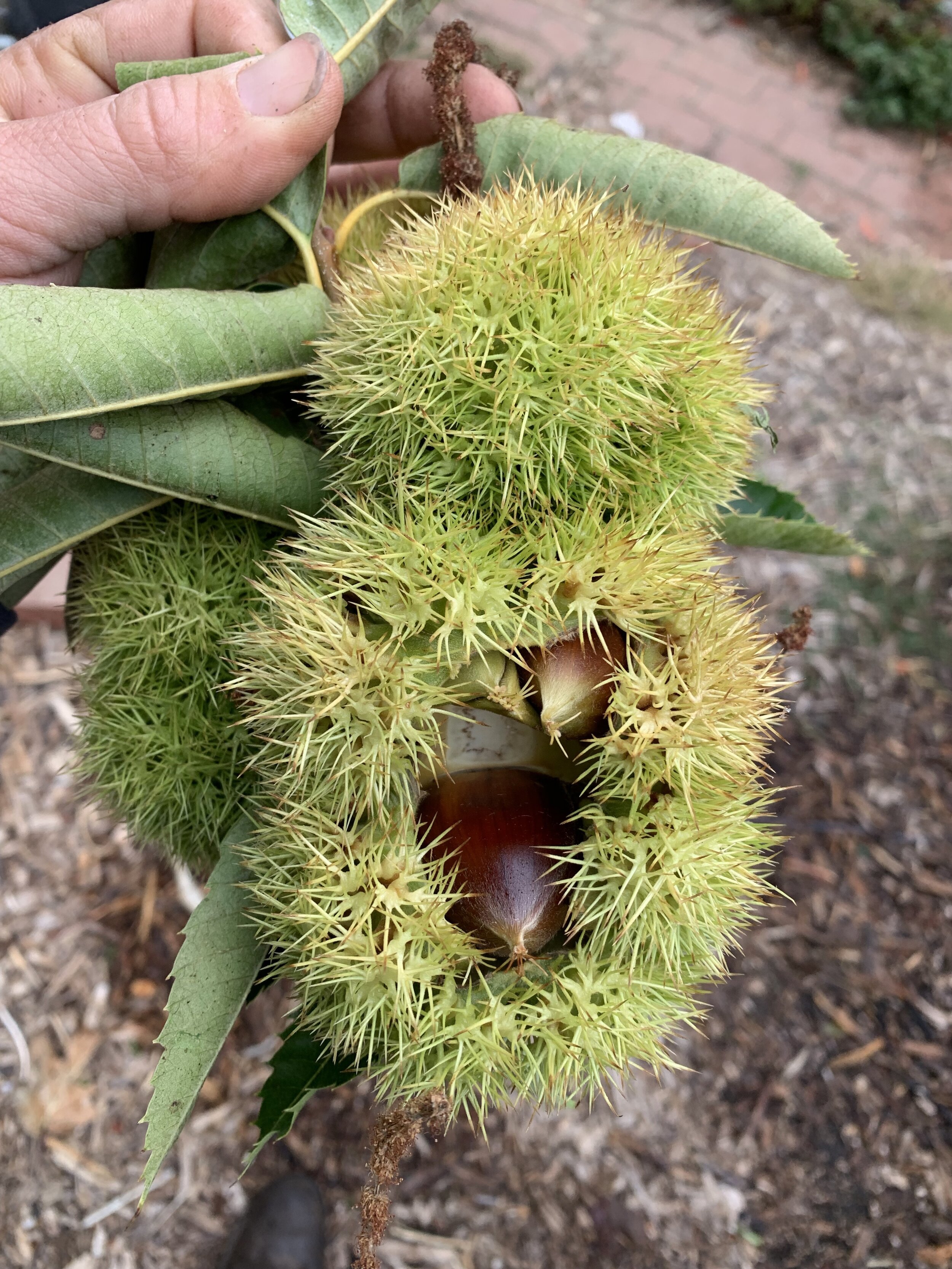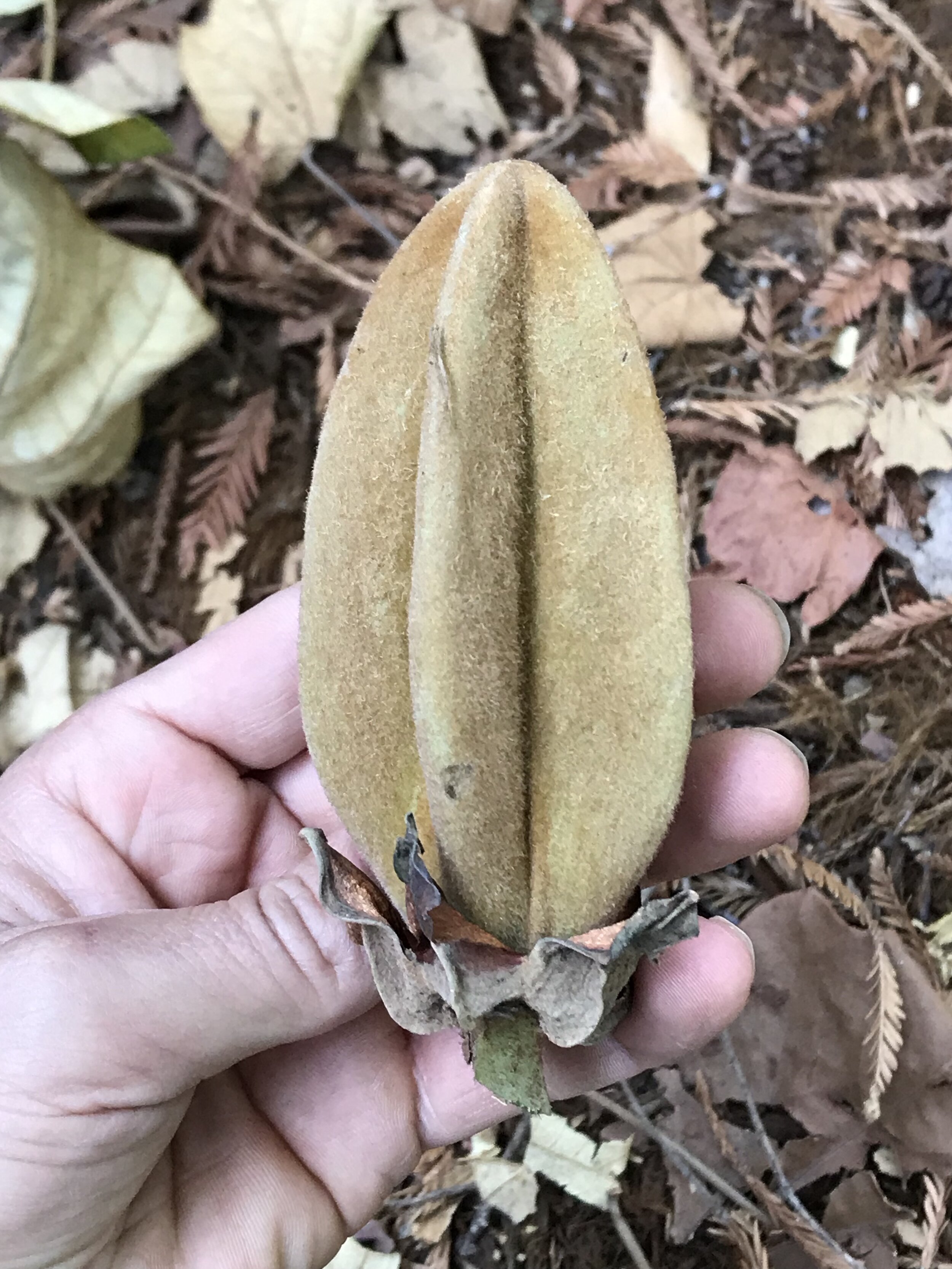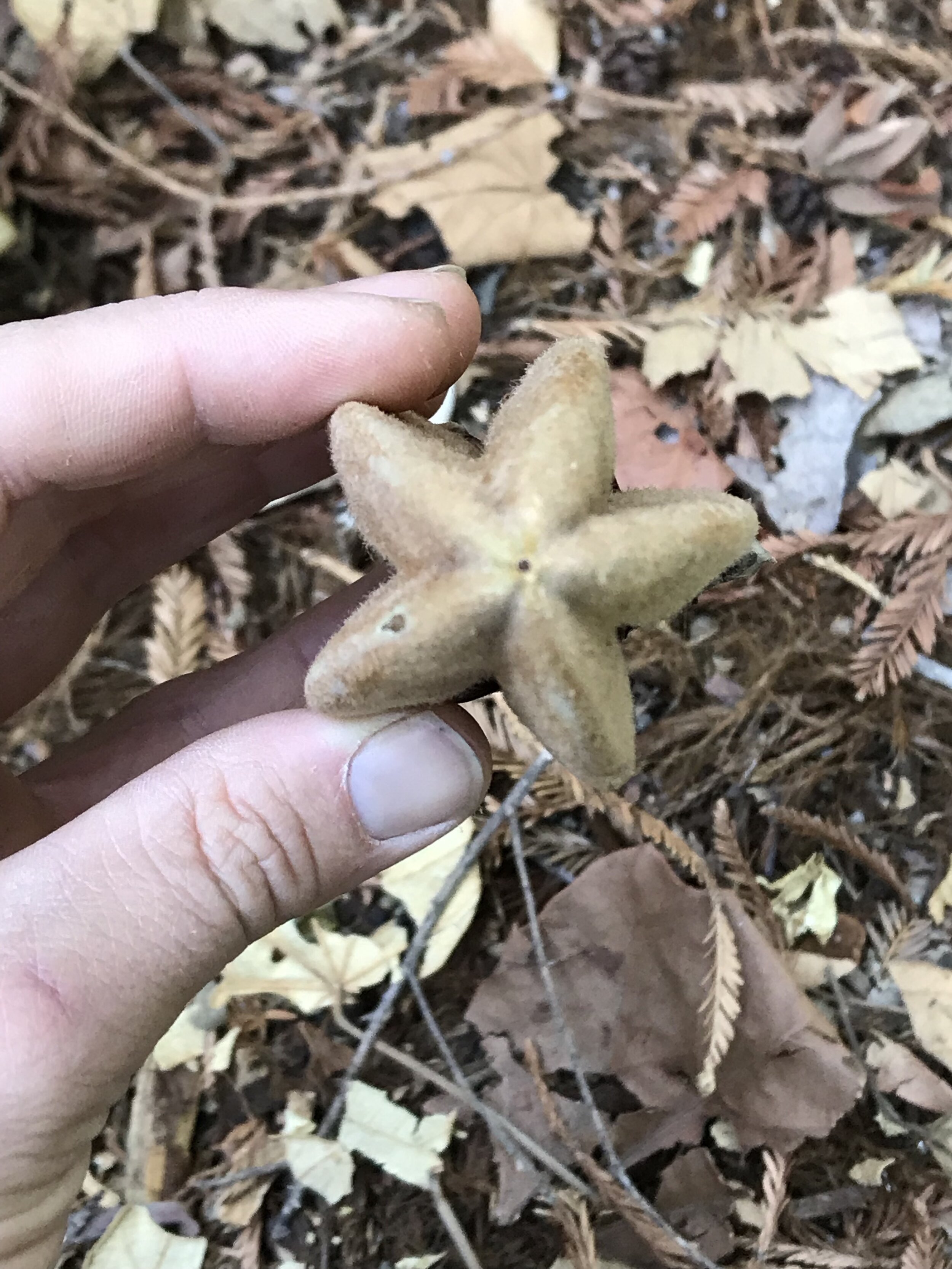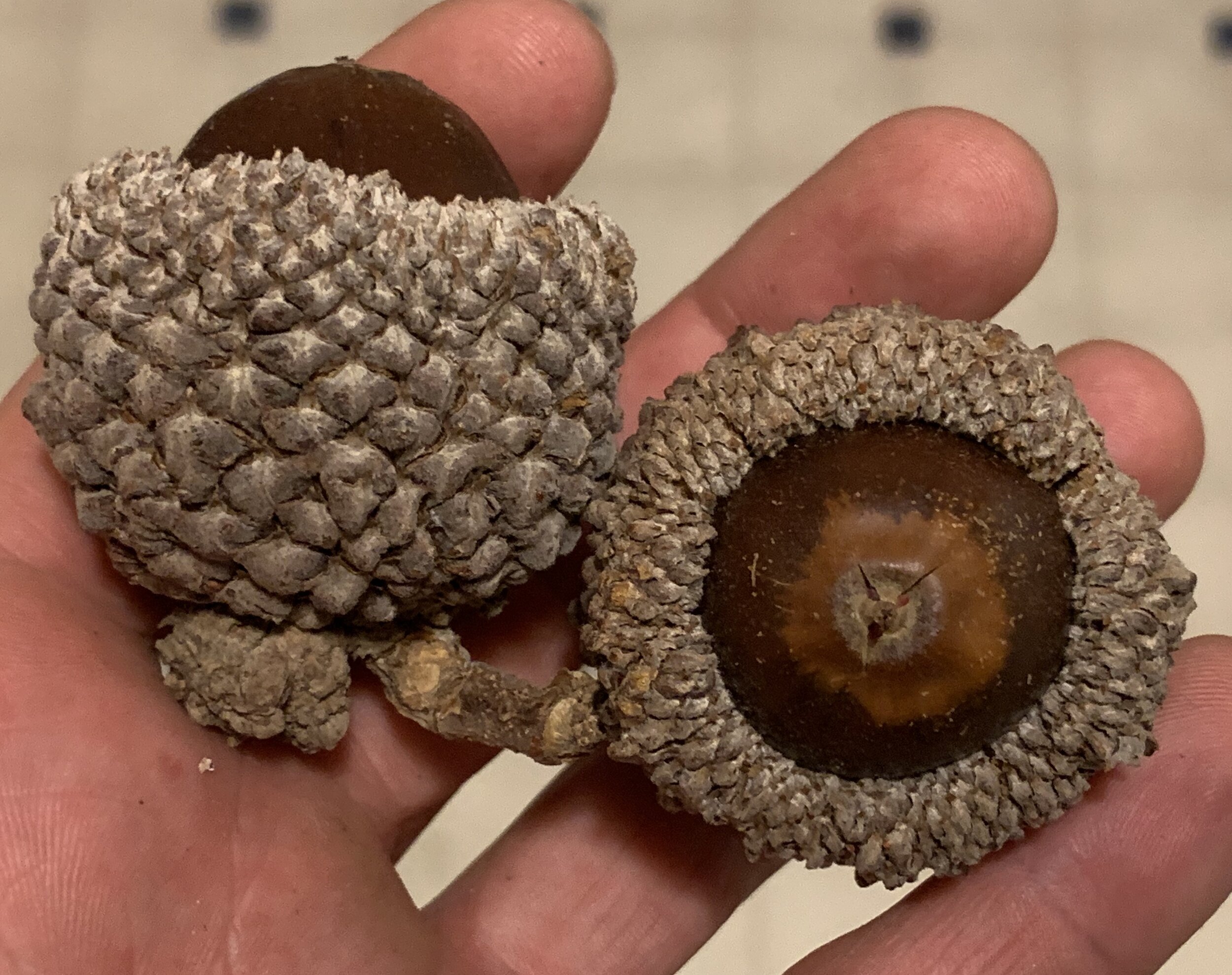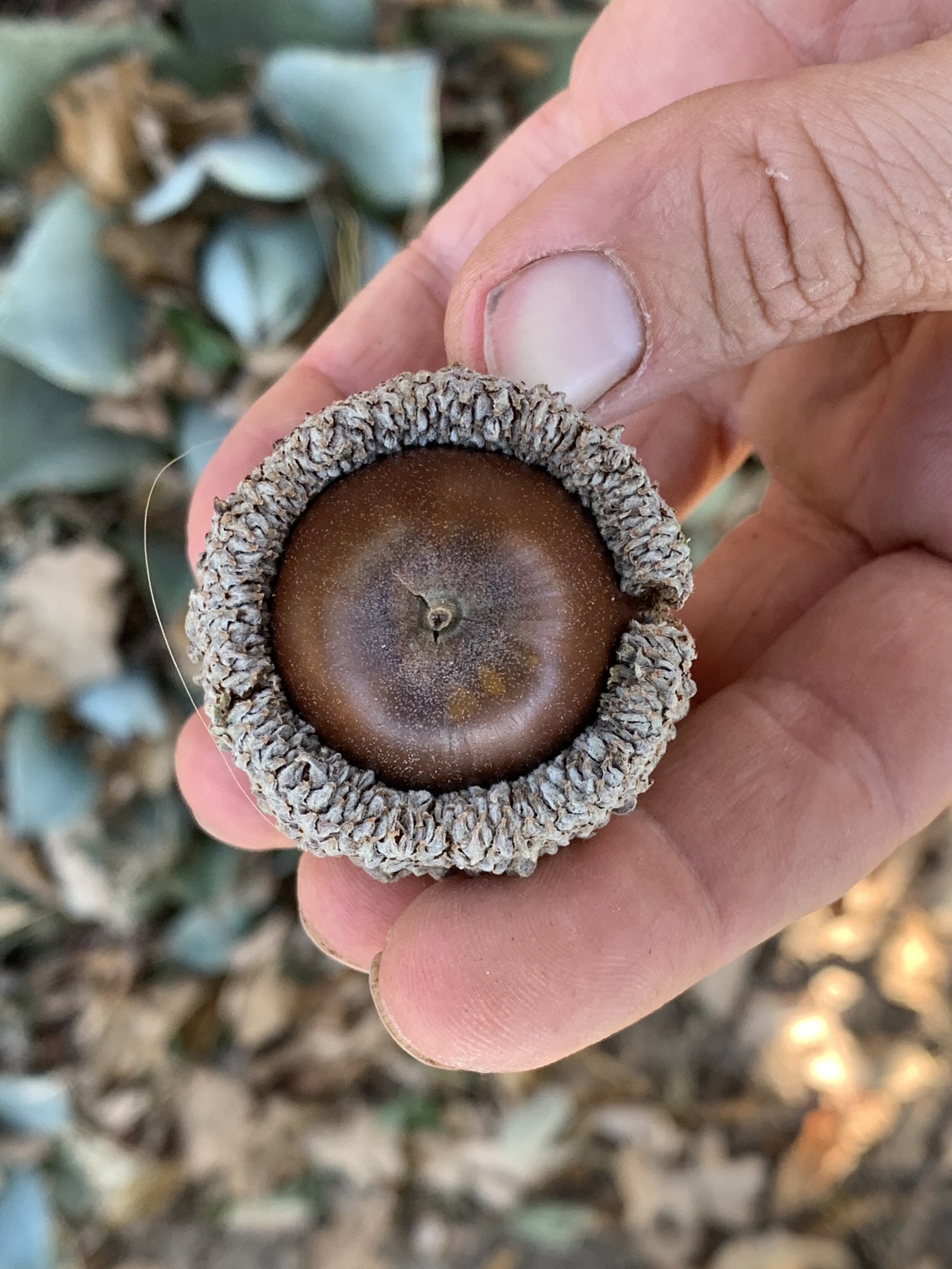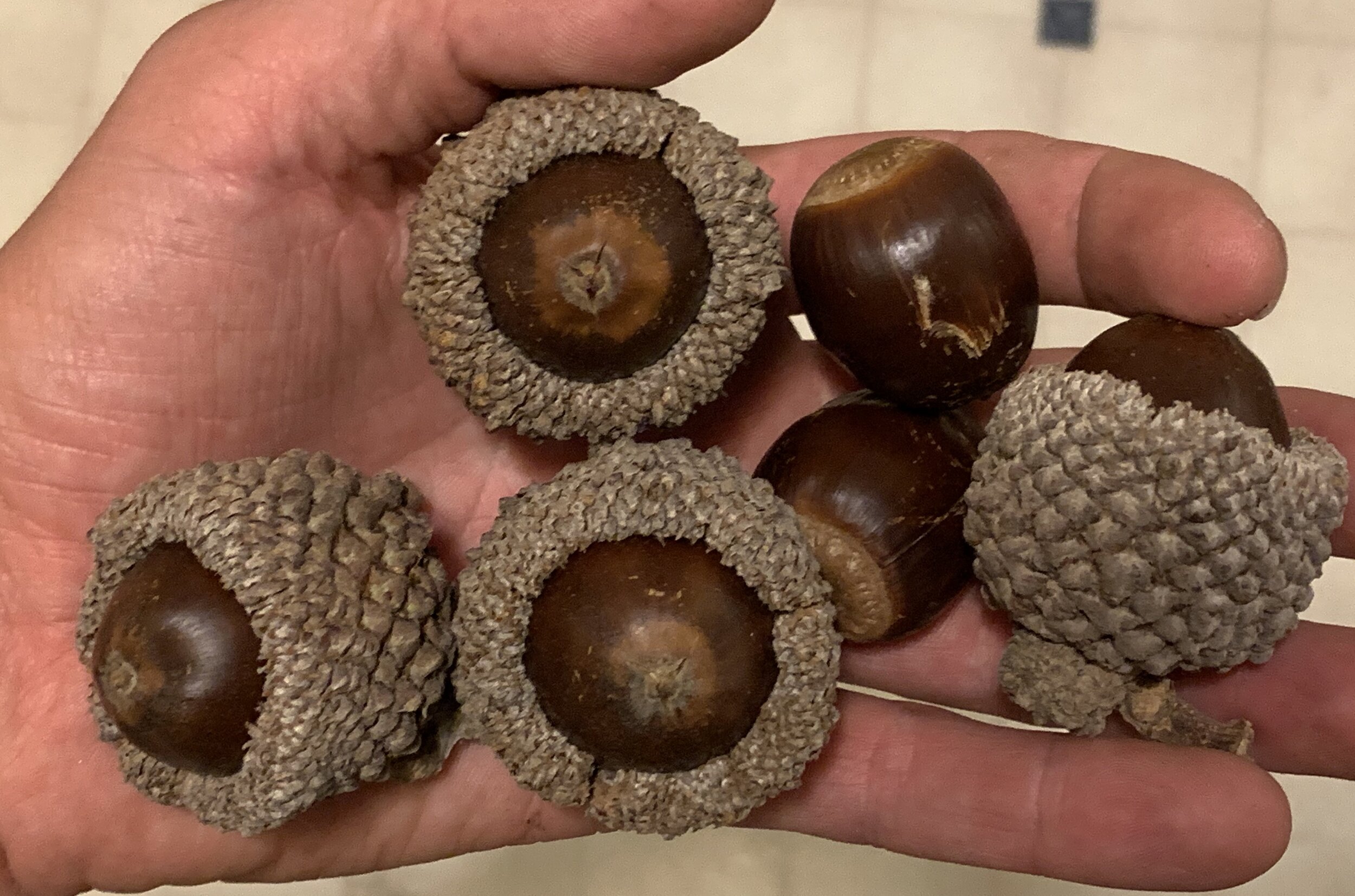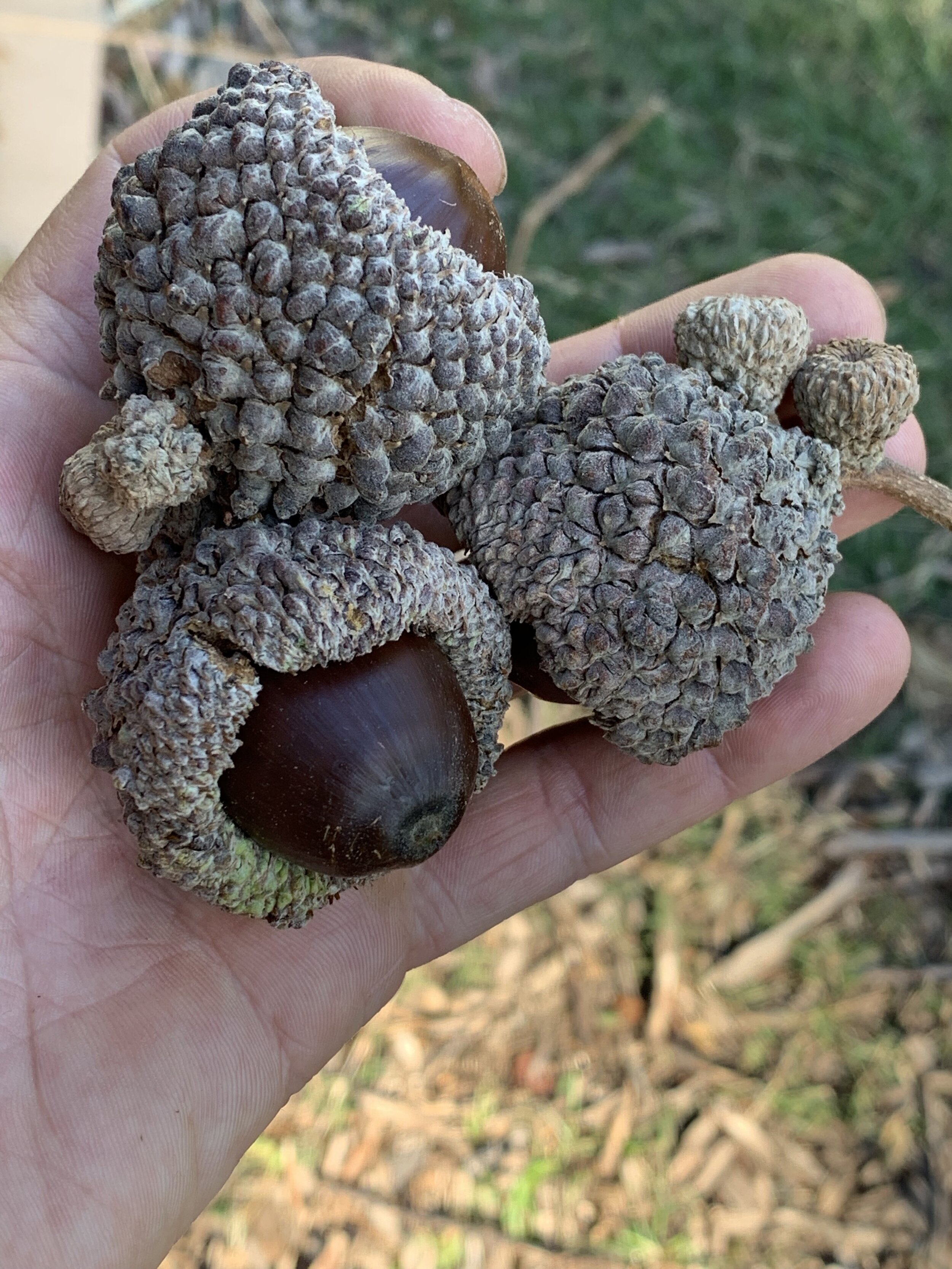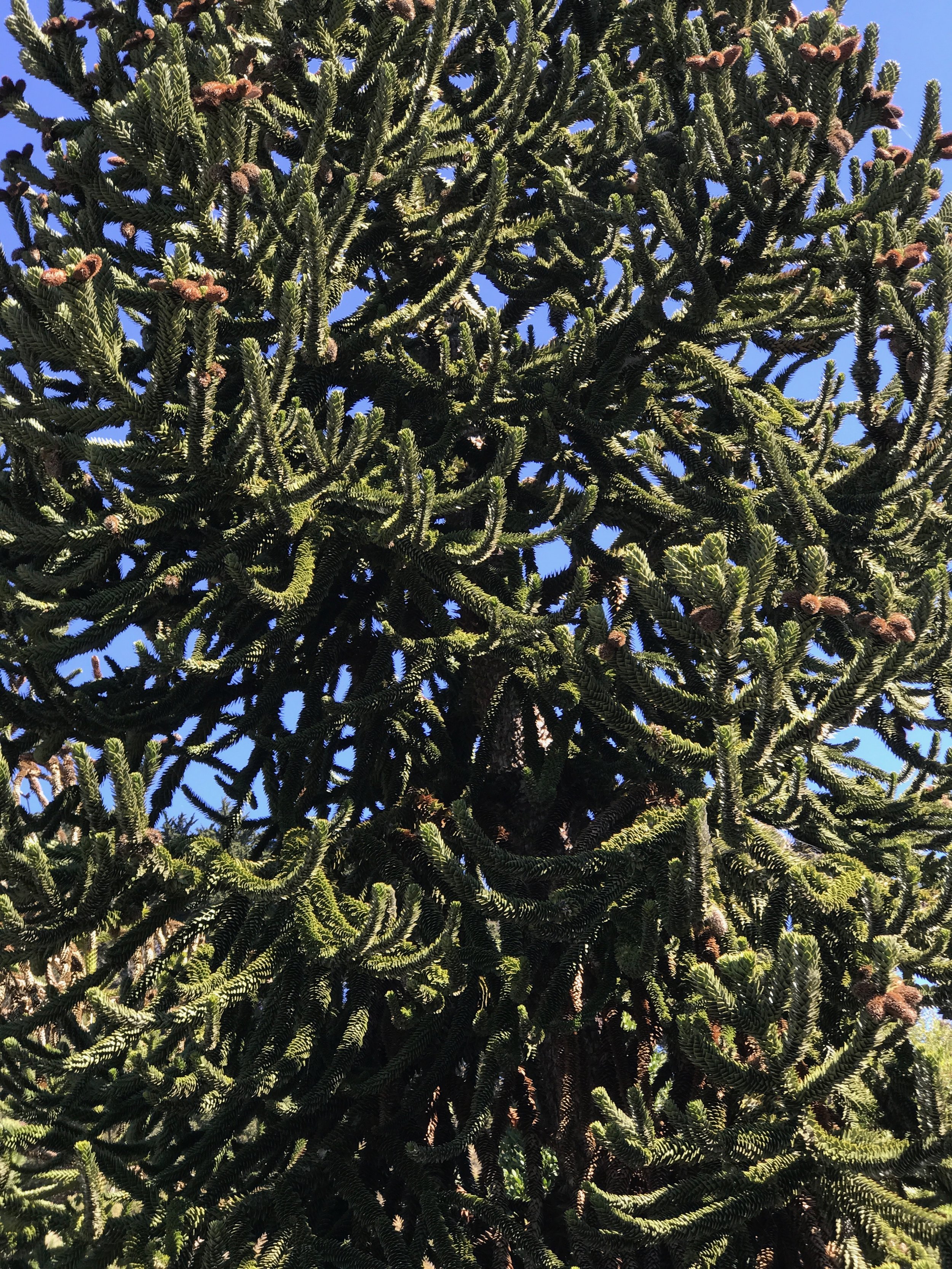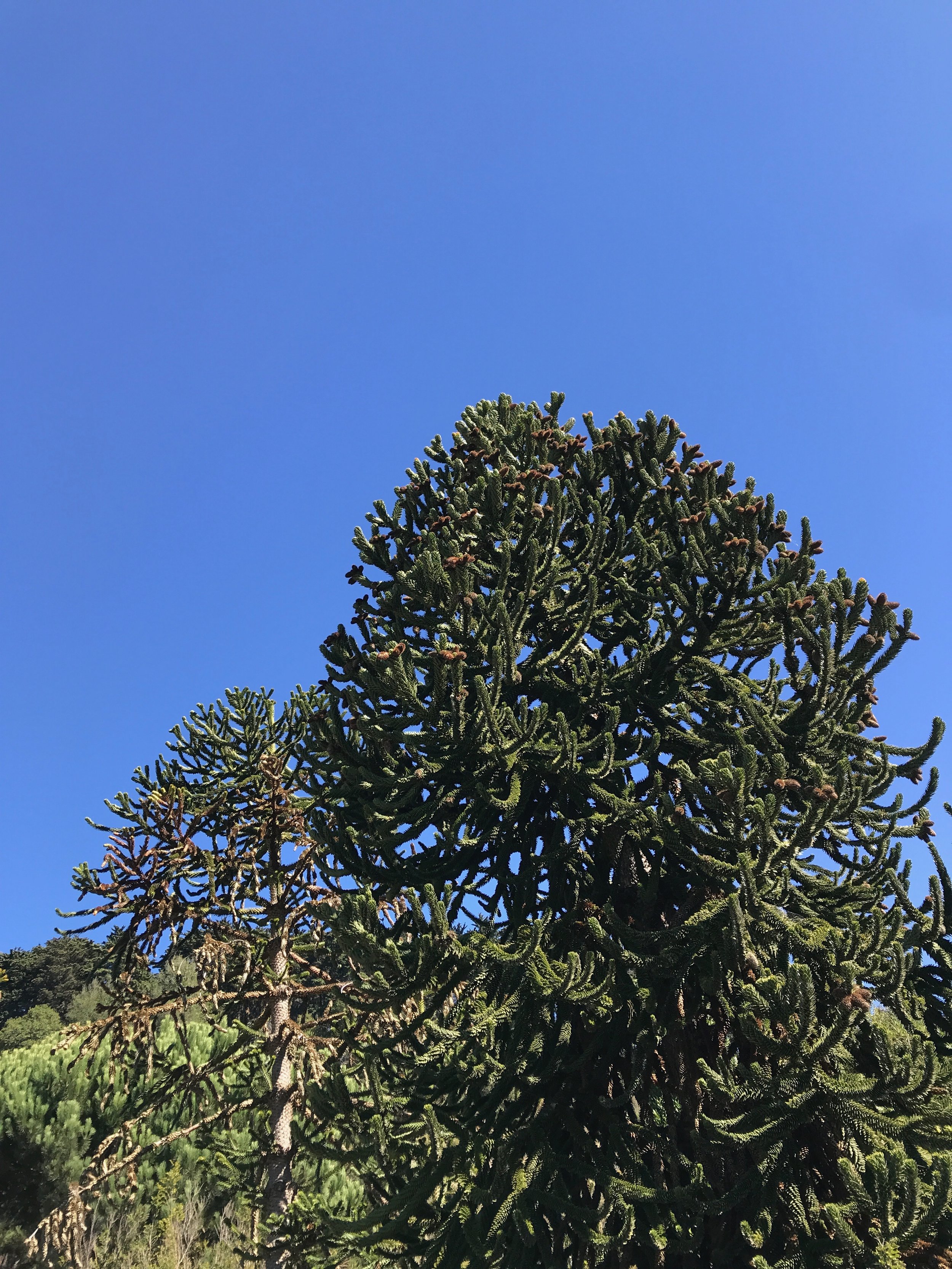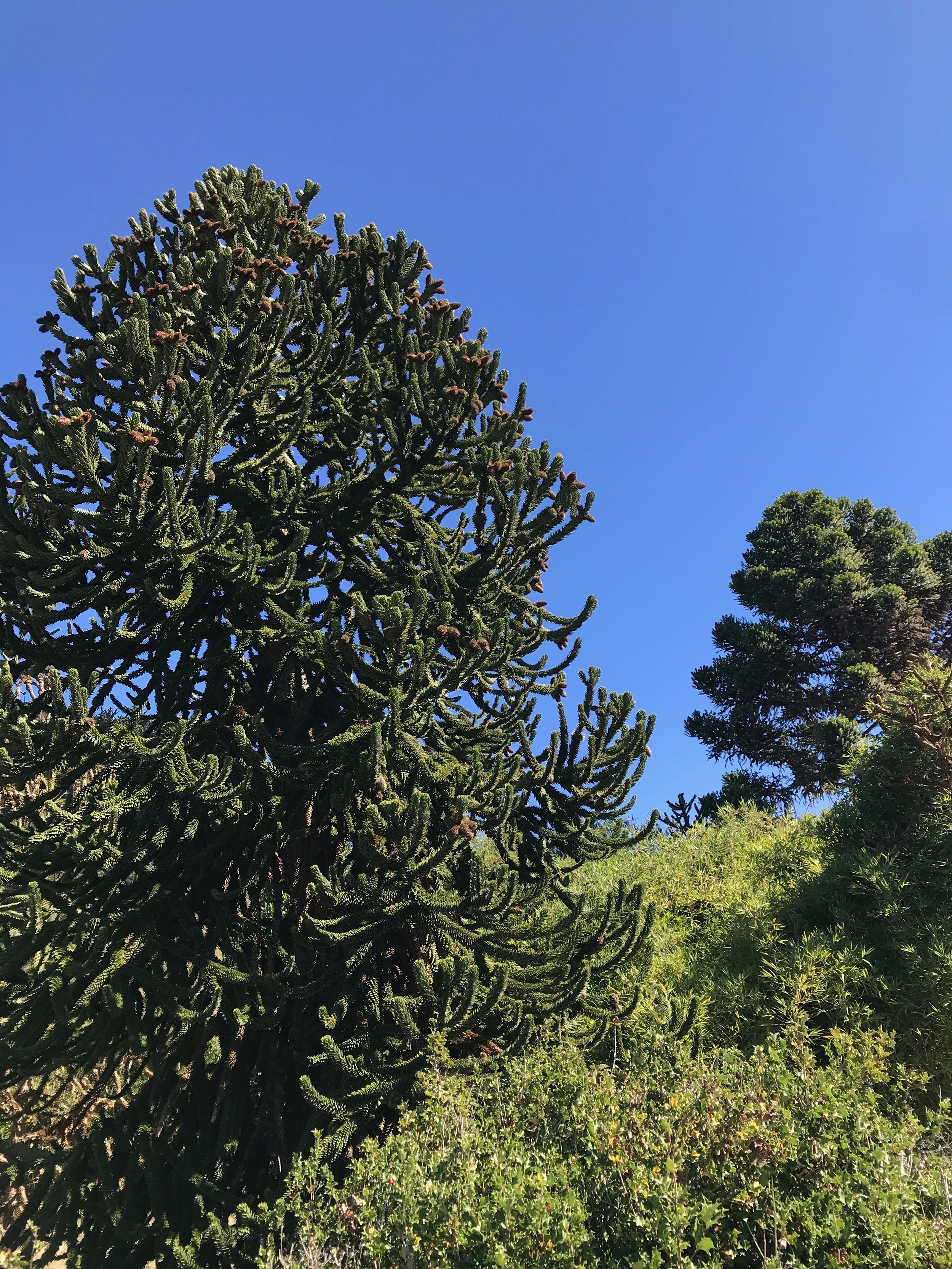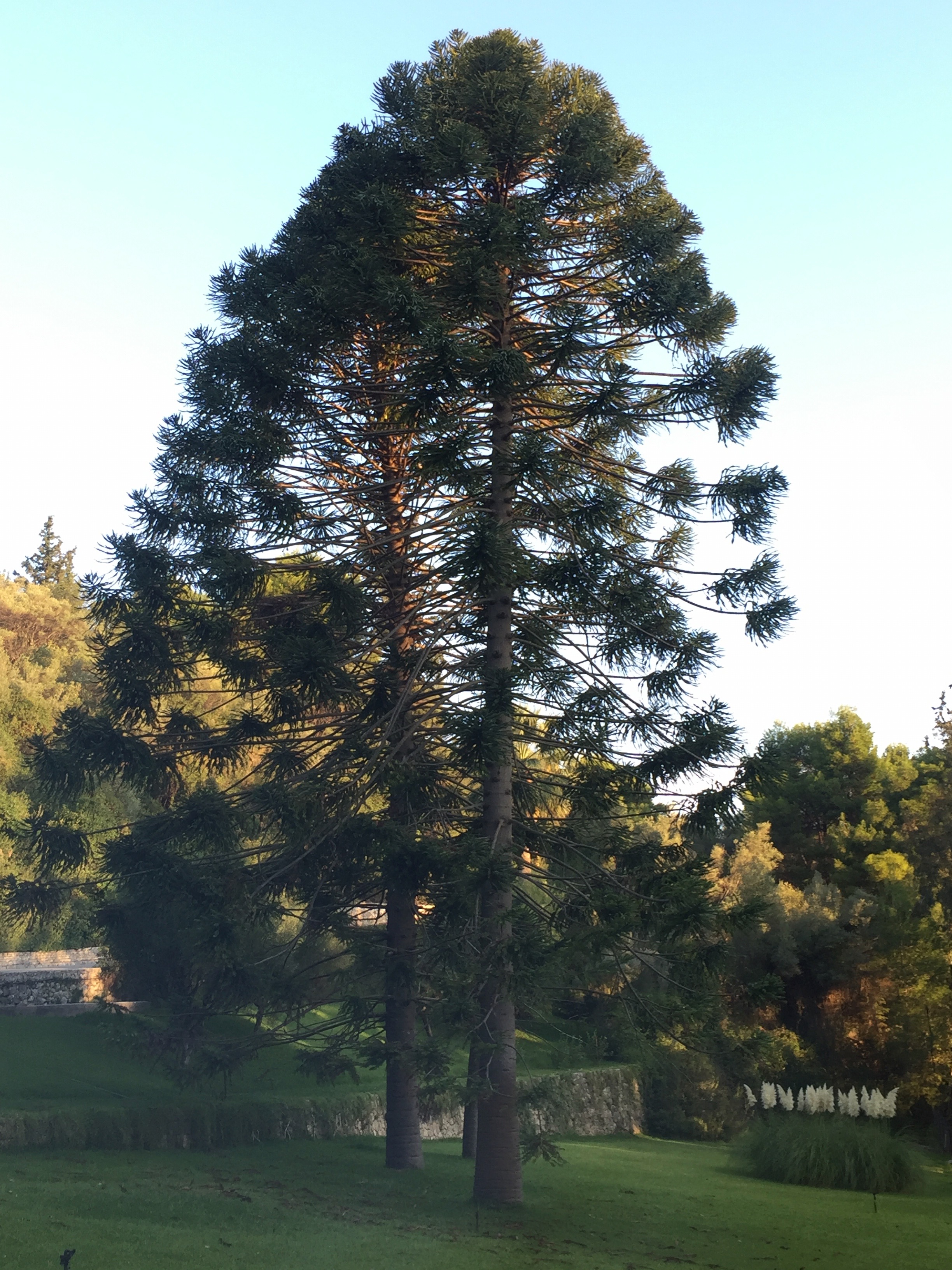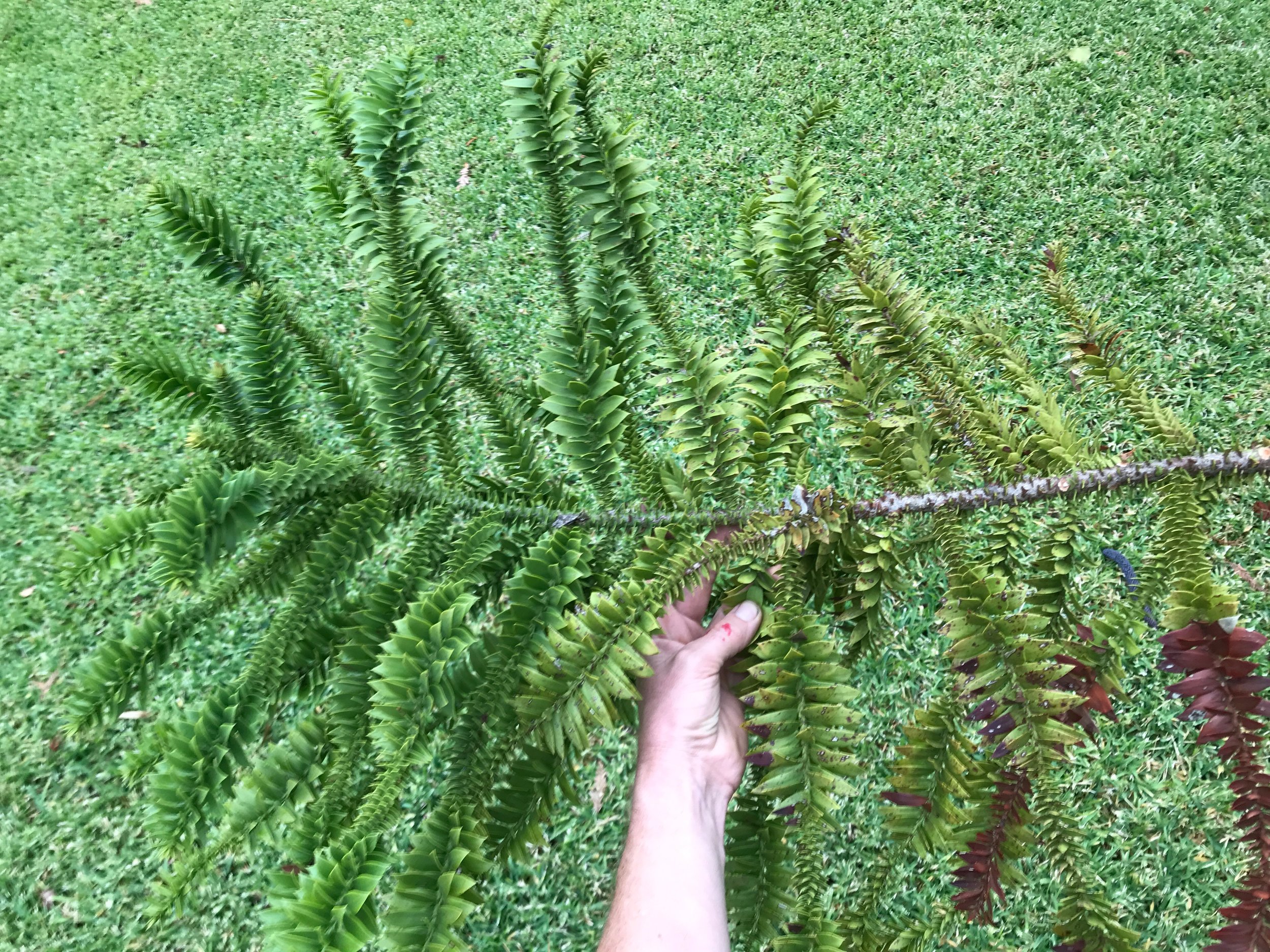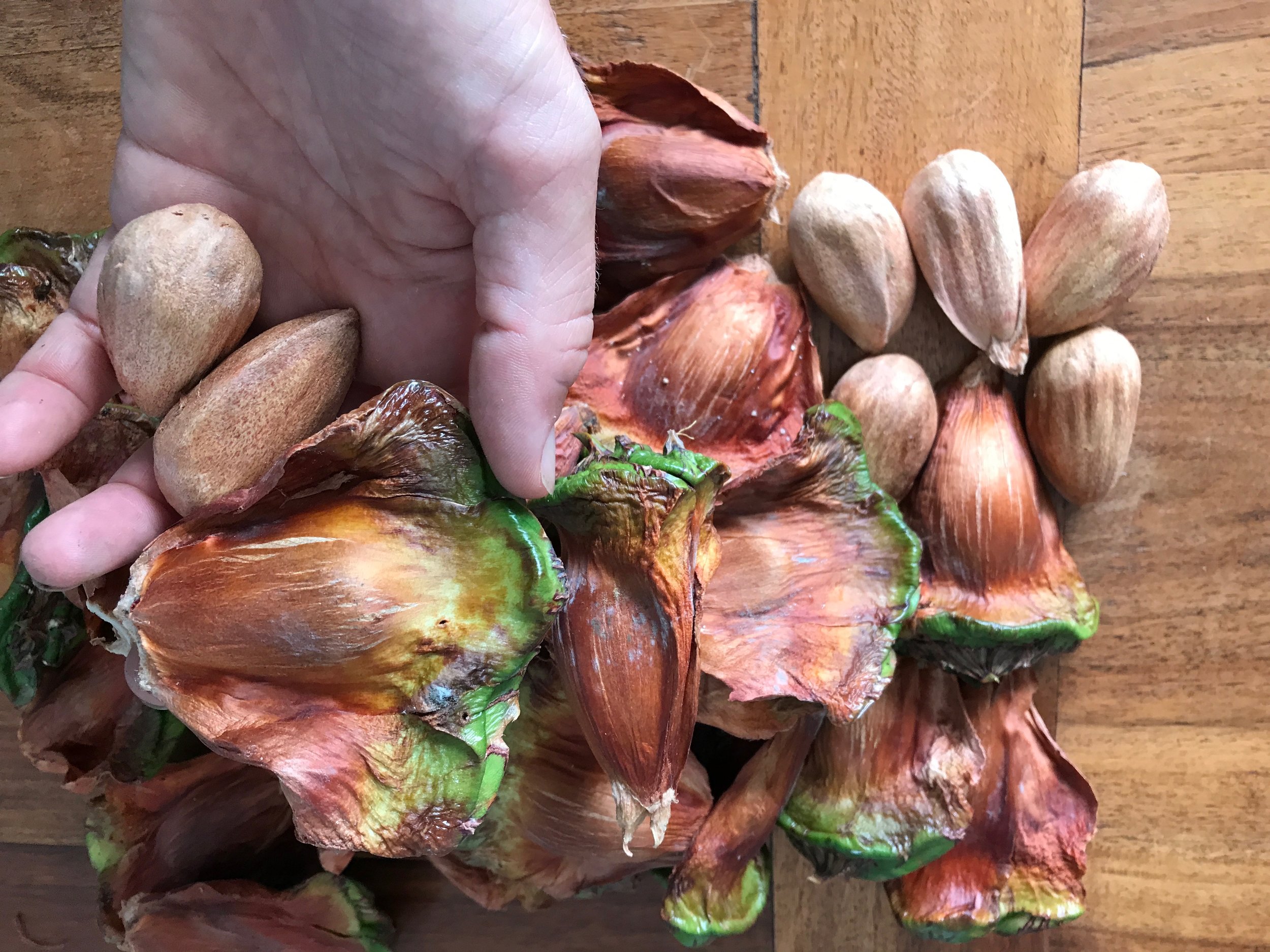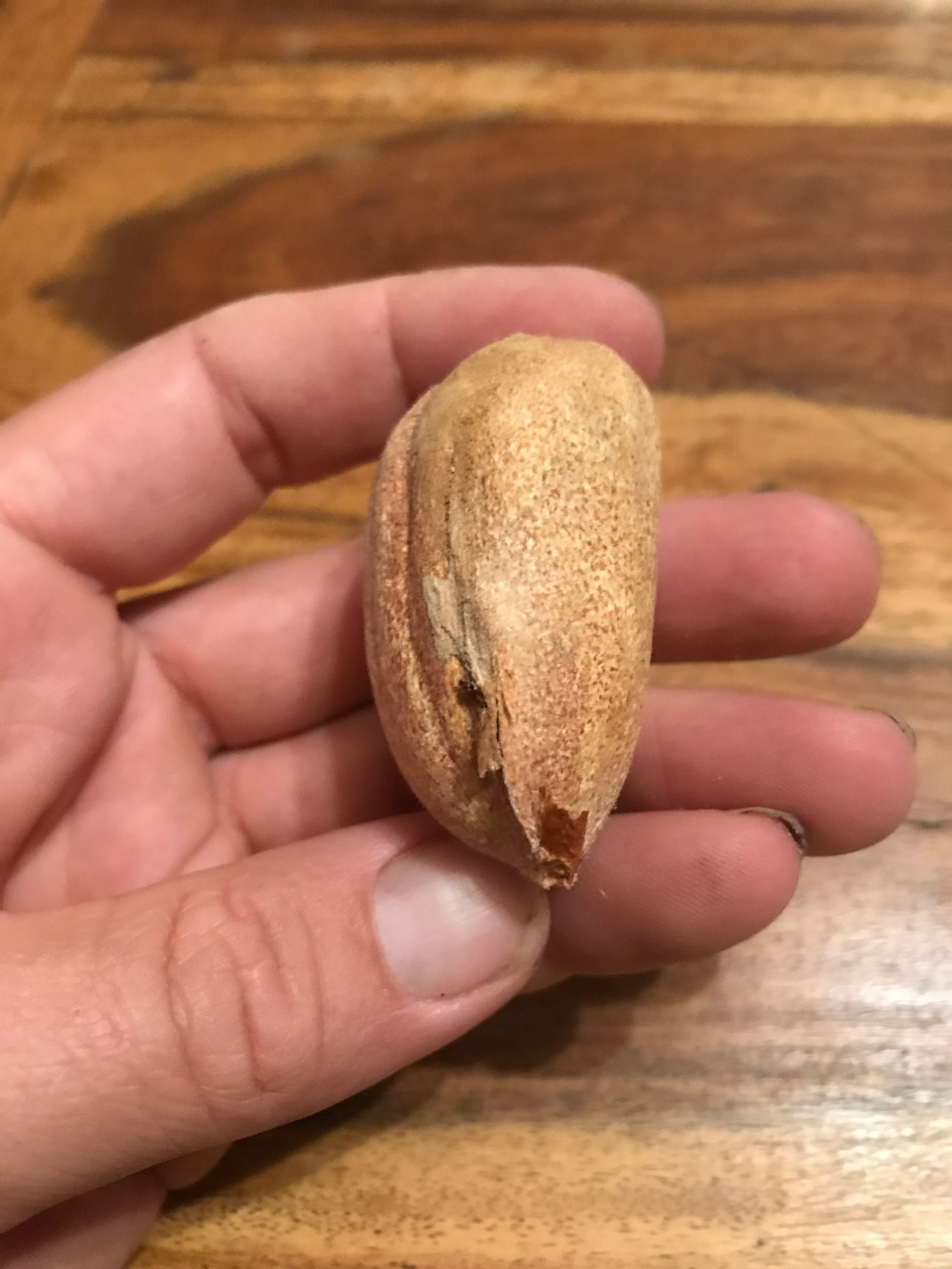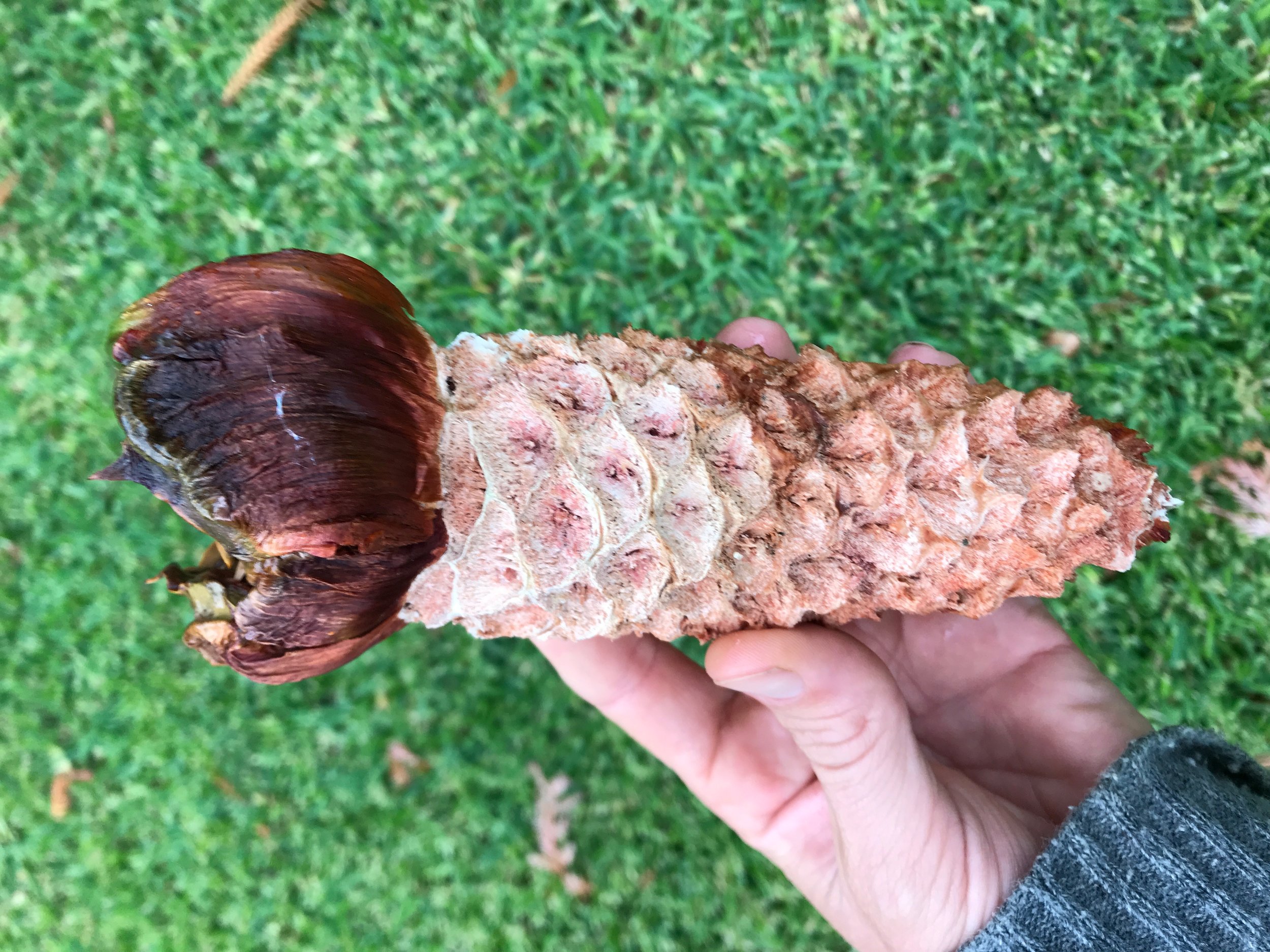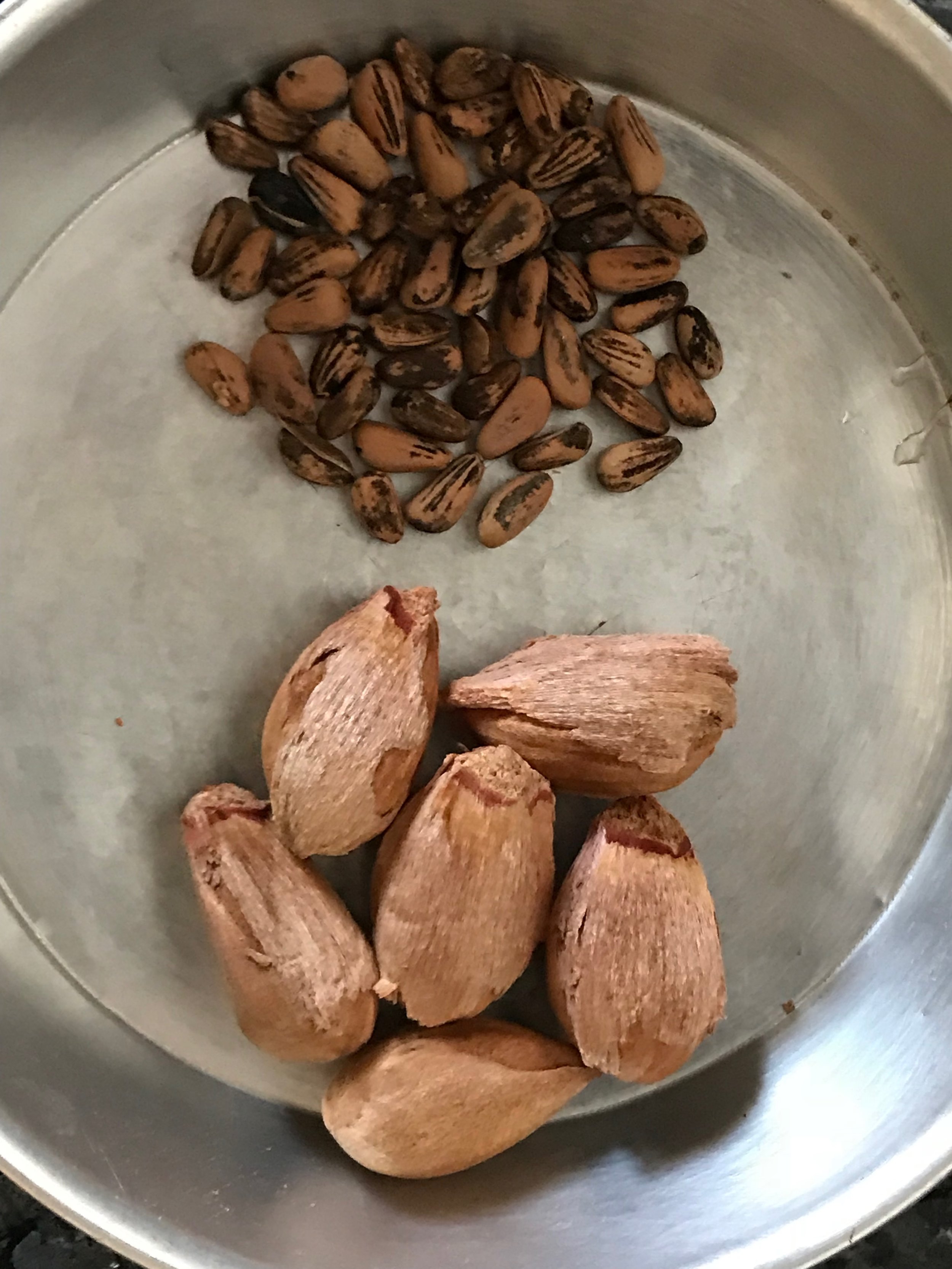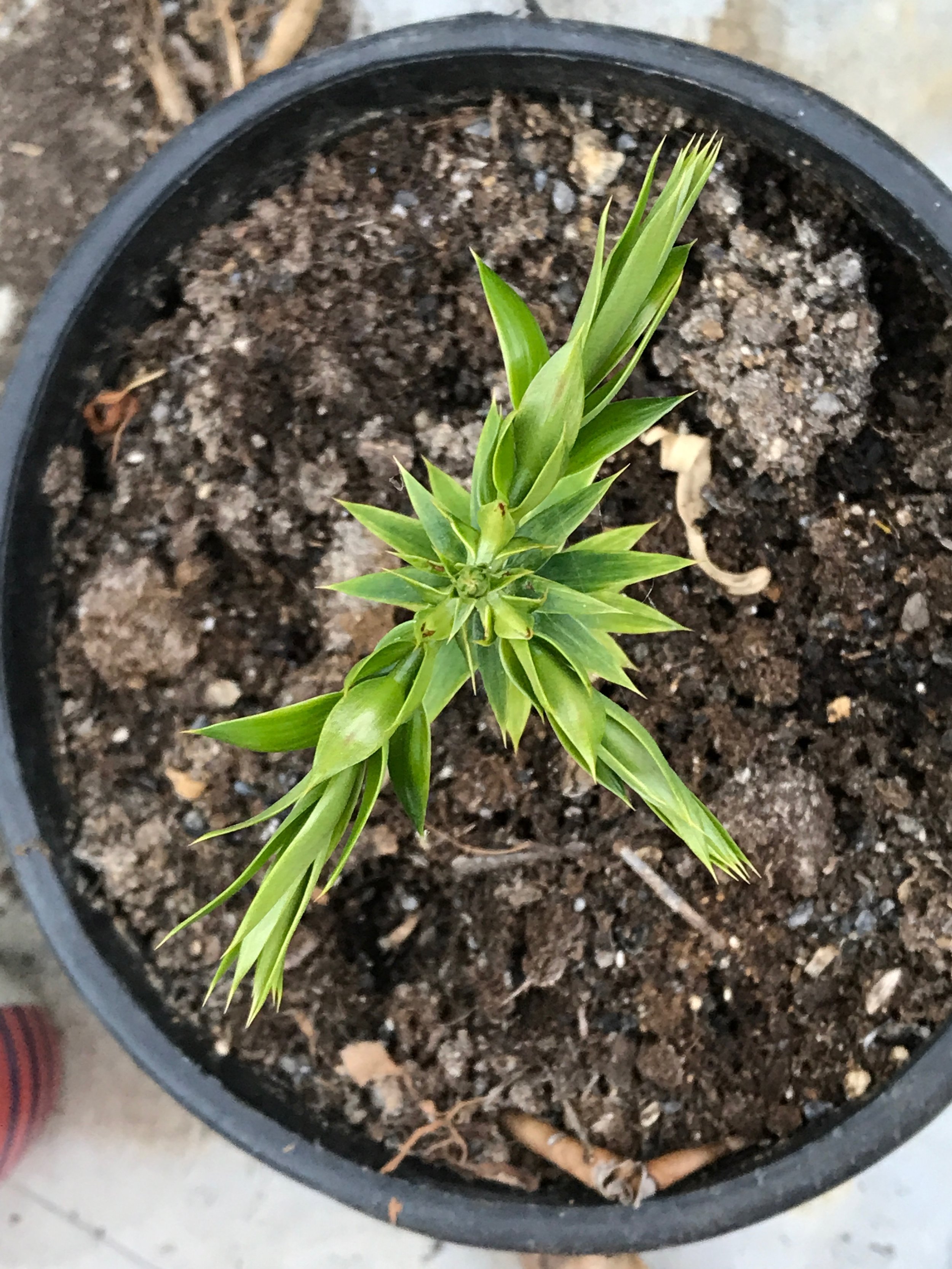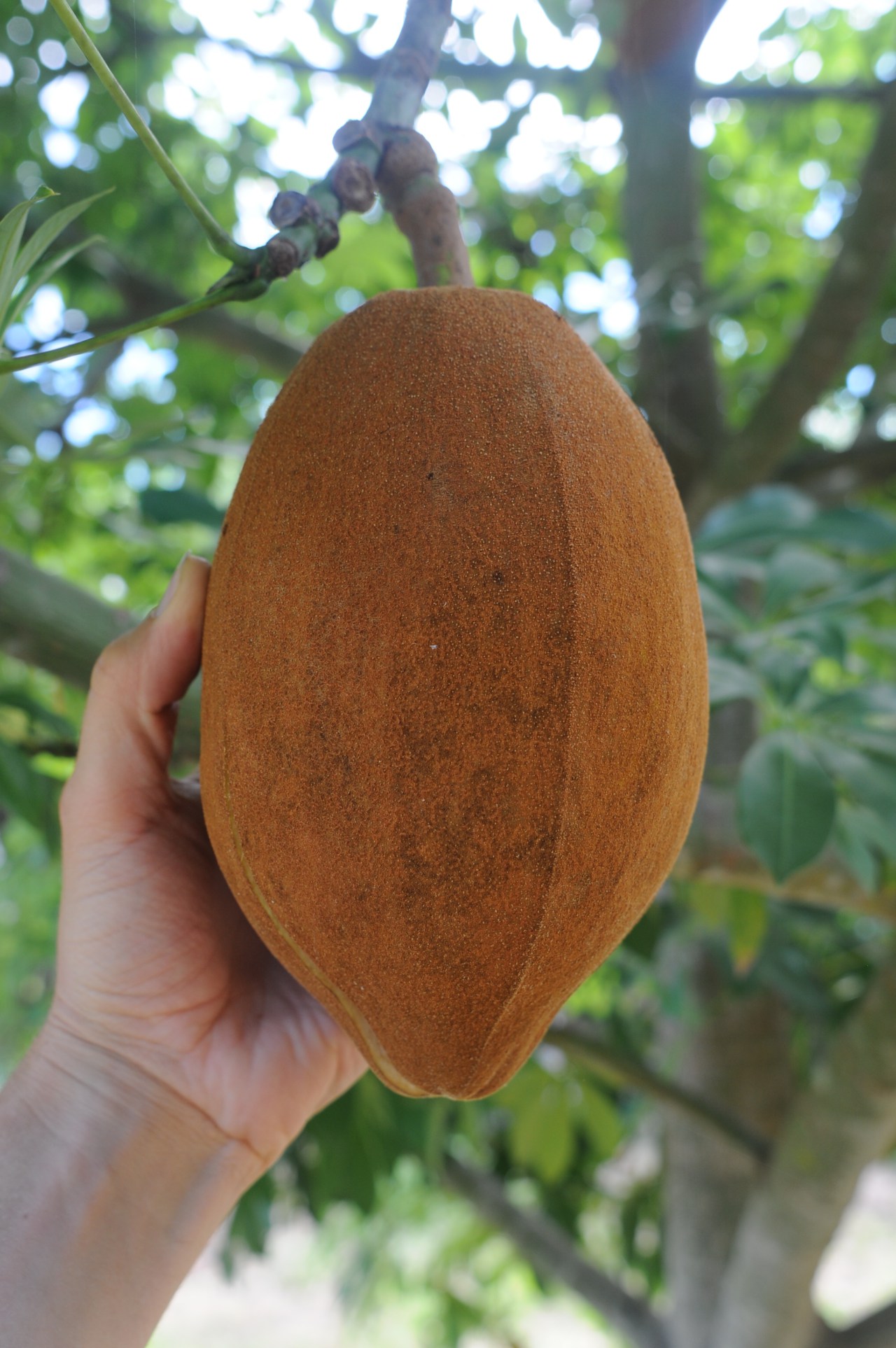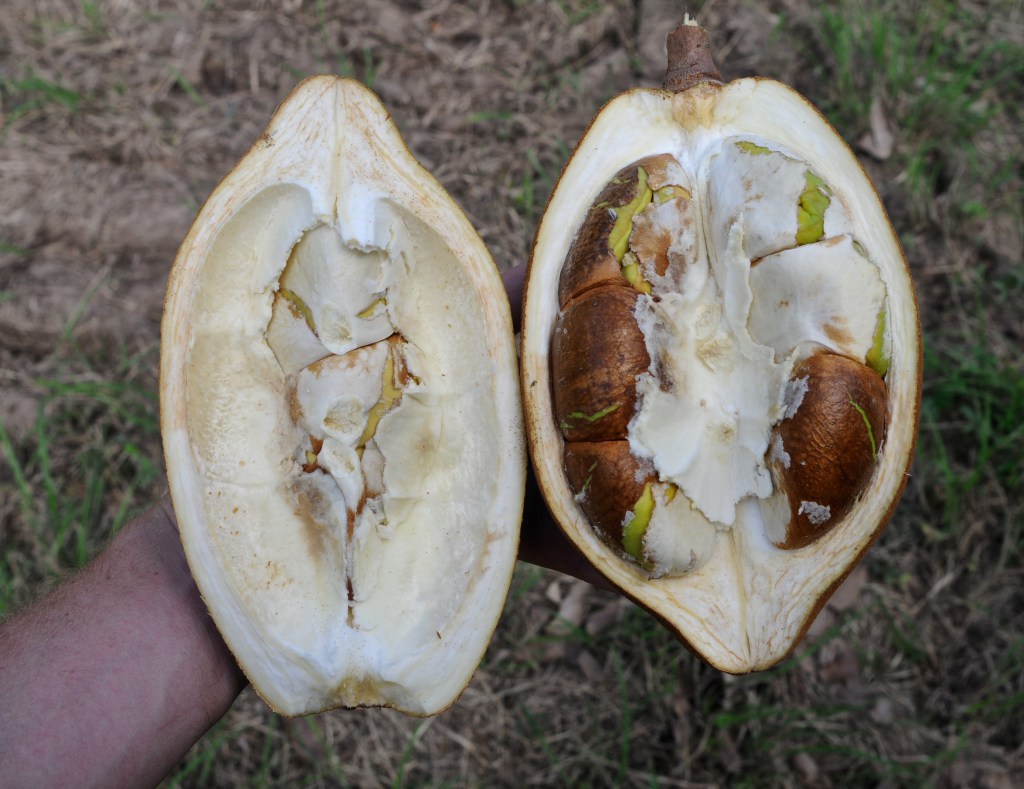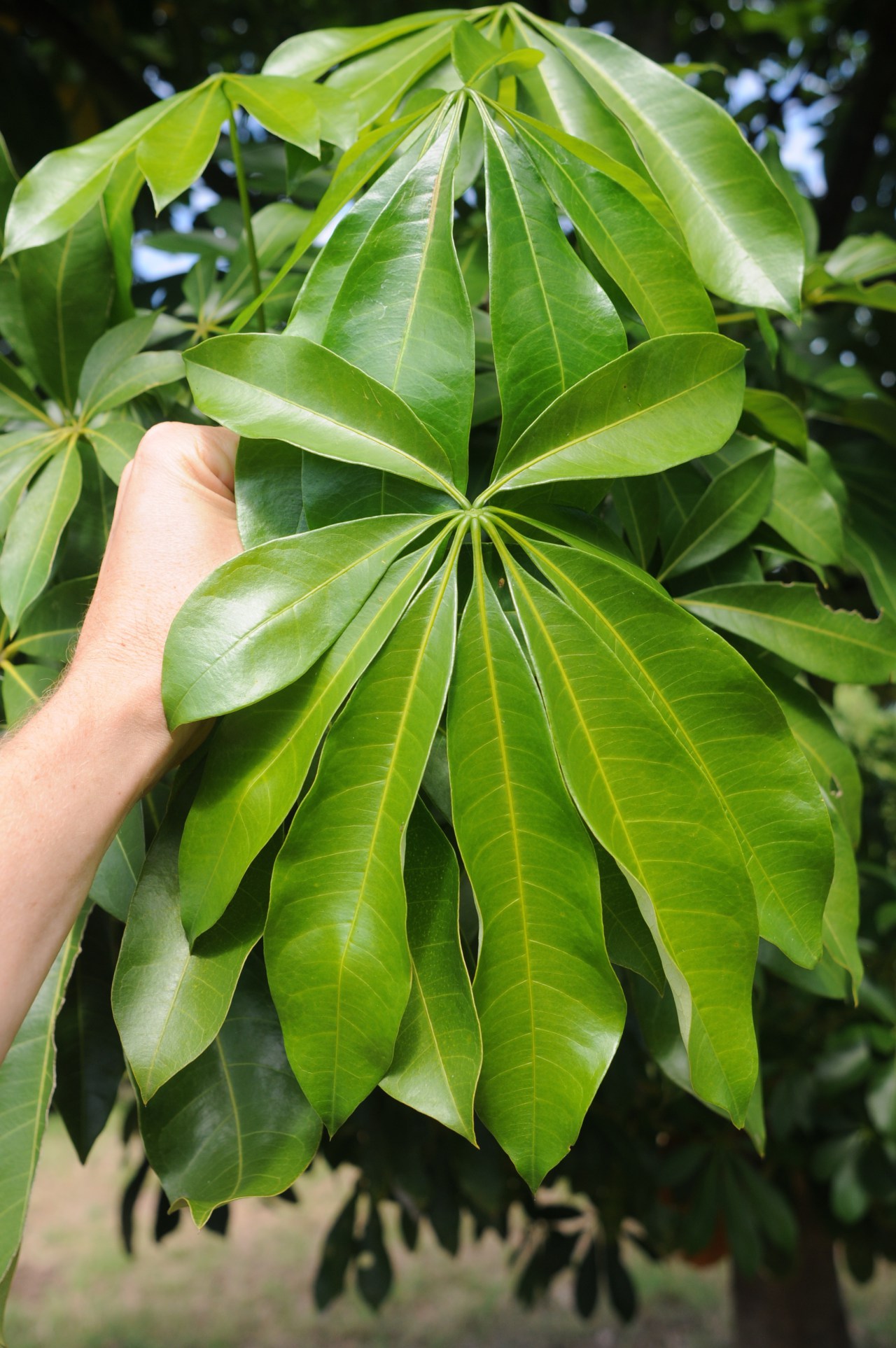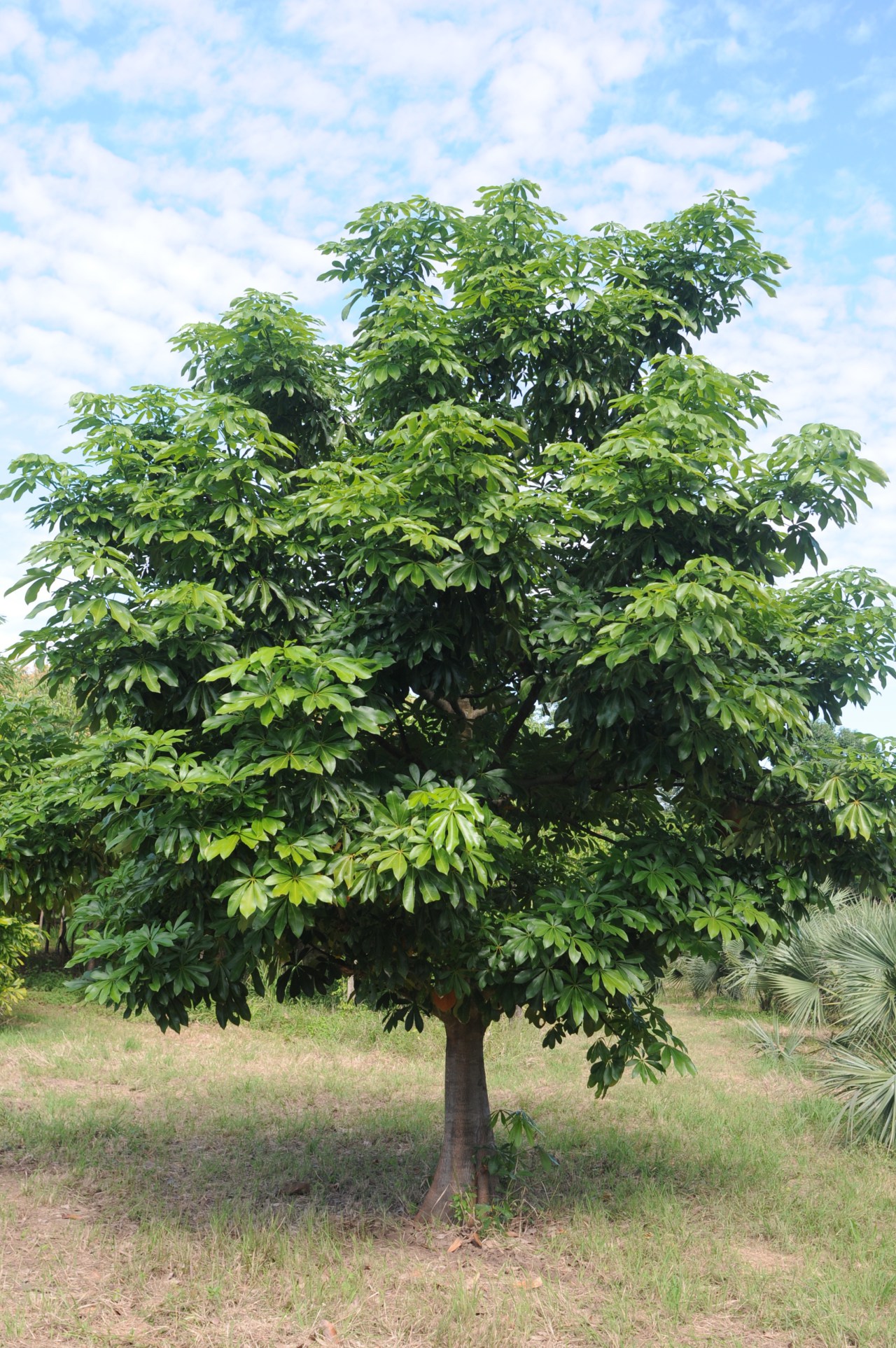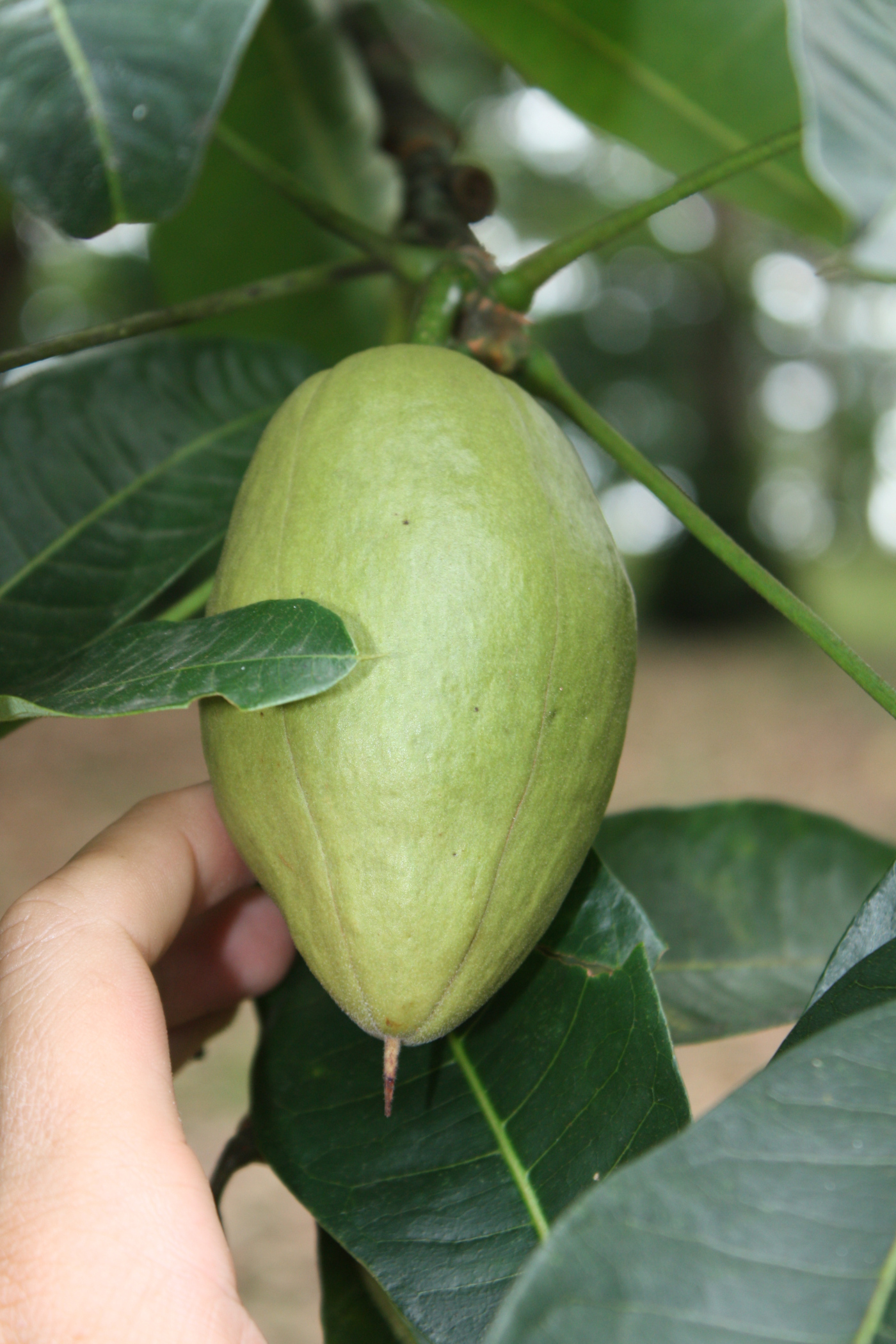Chestnuts, hazelnuts and heart nuts....
Some examples of the numerous variations of chestnut and hazel nut I am propagating this year.
Castanea spp. Luther Burbank hybrid chestnuts
Chiranthodendron pentadactylon almost ripe fruit / seedpod
The first seedpods are developing on a five year old Chiranthodendron pentadactylon tree I grew from seed.
Quercus spp., Q. macrocarpa?
I found this unusual species of Oak the other day falling from a neighborhood tree.
The closest similar oak species I can find is Quercus macrocarpa, the Burr oak or Mossy cup oak. However Q. macrocarpa has a more hairy cup with clearly visible hairs along the cup margin. In contrast the cup of this acorn was extremely thick, hard and woody, almost like scales.
One possibility is that this is a hybrid of Q. macrocarpa and some other oak species and that this acorn is an one of many phenotypic expressions.
Quercus macrocarpa is one of the largest seeded oak species in the world and the largest in N. America. The largest is the neotropical Quercus insignia. The seed is notable for its massive size and considerably low tannin content when compared to other acorns.
Any thoughts on positive ID welcomed in Comments.
Araucaria araucana - Monkey Puzzle tree
Araucaria anguvstifolia, another member of the pan-global Araucariaceae family, many of which have edible seeds and multiple other ethnobotanical uses.
Native to It is native to central and southern Chile and western Argentina. A. araucana is the national tree of Chile. Its conservation status was changed to Endangered by the IUCN in 2013 due to the dwindling population caused by logging, forest fires, and grazing.
The large seeds, or pinions, are edible can be consumed, prepared in a wide variety of ways. The tree, however, does not yield seeds until it is around 30 to 40 years old, which discourages investment in planting orchards (although yields at maturity can be immense); once established, it can live possibly as long as 1,000 years.
Araucaria bidwillii - Bunya-Bunya pine
Theobroma cacao- Chocolate, Cacao
BACKGROUND, ORIGIN AND DISTRIBUTION
There's a lot that can be said about this species.
Theobroma cacao ripe pods.
Some of the latin synonyms are: Cacao guianensis Aubl., Cacao minus Gaertn., Cacao sativa Aubl., Theobroma caribaea Sweet, Theobroma interregima Stokes, Theoboma kalagua De Wild, T. leiocarpa Bernoulli, T. pentagona Bernoulli.
Some of the folk names include: Ah kakaw (Lacandon), aka-'i (Ka'apor), aka-'iwa (Ka'apor), bana torampi (Shipibo), biziaa (Zapotec), bizoya, cacahoaquiahuit, cacahoatl, cacahua, cacahuatl, cacao, cacaocuahuitl (Aztec).
The list of folk names goes on and on. Cacao has been a significant species for melenia. The tree was cultivated throughout areas of Central America 4,000 years ago where it was venerated as a divine substance, a food of the gods, and was primarily consumed during rituals and offered to the gods. Thus the plant genus is called Theobroma, meaning "gods" "food" in Latin. Cacao is a word borrowed from the Mayan language and refers to the tree, the fruit, and the drink that is prepared from the fruit. The word chocolate is derived from the Aztec word xocolatl.
USES AND ETHNOBOTANY
Cacao beans were held in extremely high regard by the Aztecs who used them as food, stimulant, medicine and currency. Notably, as a currency, the cacao bean was typically used as standard fare to pay prostitutes. Perhaps this has something do to with the beans aphrodesiac properties.
The Aztec viewed the cacao tree as a gift form the god Quetzalcoatl. The following, extracted from an Aztec text, provides a precise description of the tree and of the drink:
Cacaoaquavitl - Cacao Tree
It has broad branches. It is simply a round tree. Its fruit is like the ears of dried maize, like an ear of green maize, some whitish brown. Its name is "cacao ear." Some are reddish brown, some whitish brown, some bluish brown. Its heart, that which is inside it, its filled insides, is like an ear of maize. The name of this when it grows is cacao. This is edible, is drinkable. This cacao, when much is drunk, when one consumes much of it, especially that which is green, which is tender, makes one drunk, has an effect upon one, makes on ill, makes one confused. If a normal amount is drunk, it makes one happy, refreshes one, comforts one, strengthens one. Thus it is said: "I take cacao, I moisten my lips. I refresh myself." (Sahagun, 11)
Initially, when cacao beans were first brought to Europe by Hernan Cortez it was used almost exclusively in the production of love drinks
Today, although the wild form of the plant (T. lacandonense) is found only in the jungles of southern Mexico, domesticated cacao can be found grown as a crop throughout many of the tropical rainforest regions of the world, throughout the Americas, in southeast Asia, and parts of Africa.
I have found wild cacao relative, Herrania purpurea, on an island off the Caribbean coast of Panama. The pod is smaller than T. cacao. When opened the pod contains a similar white pulp surrounding smaller seeds.
Interestingly, in ancient Nicaragua, cacao farmers were required to abstain from sex for thirteen days prior to planting cacao seeds so they would not make the chocolate god (moon god) angry.
Generally speaking, cacao served (and still serves) the important function as a vehicle for administering other psychoactive plants and fungi (Ott 1985). The Aztecs ingested cacao together with entheogenic mushrooms (Psilocybe spp.) Associated rituals are still practiced amongst numerous tribes today.
In ancient America, cacao was esteemed as a tonic and aphrodisiac. Cacao is also used in indian fold medicine to treat diarrhea and scorpion stings. Kuna women (Panama) drink a decoction of the fruit pulp as a pregnancy tonic. Fresh young leaves are applied externally as an antiseptic agent. In Peru, cacao is drunk primarily as a diuretic and in cases of kidney infection.
Cacao beans contain 18% protein, 56% lipids, 13.5% carbohydrates, 1.45% theobromine, .05% caffeine, and 5% tannin.
The following cacao recipe was said to have been brought by conquistador Hernan Cortez to Spain in 1528:
700 g cacao
750 g sugar
56 g cinnamon (probably Canella winterana)
14 Mexican peppercorns (Capsicum spp.)
14 g spice cloves (Pimenta dioica)
3 vanilla pods
1 handful of anise (probably Tagetes lucida)
1 hazelnut
musk, grey amber, and orange blossom water
Pachira aquatica - Guinea Chestnut, Apompo
Pachira aquatica is a medium size tree native to tropical wetlands of Central and South America. Its native habitat tends to be seasonally flooded lowlands or swamps, however it is adaptable to a wide range of tropical environments. The large, oblong fruit is full of large seeds which taste reminiscent of peanuts, and can be eaten raw, cooked, or ground into flour to make bread. The leaves and flowers are also edible.
Interestingly Pachira aquatica and close relative Pachira glabra are both used and sold with braided trunks as the "money tree", an indoor plant that is supposed to bring monetary wealth. Personally I prefer to plant them in the ground outside.
Pachira glabra - Saba nut, Guinea peanut, French peanut
BACKGROUND, ORIGIN AND DISTRIBUTION
Originating in Mexico, Guiana, and northern Brazil, Pachira glabra is similar looking and closely related to Pachira aquatica, the Malabar chestnut. In Brazil the Saba nut is a fruit tree, cultivated as an ornamental in south-eastern areas of the country. It is not very frequent in its natural habitat, the pluvial Atlantic forests from Pernambuco to Rio de Janeiro and the flood plain forests of Para and Maranhao. Today this species is distributed throughout the tropical world, used both as an ornamental tree and a food crop.
It is a small evergreen tree 4-6 m tall. The fruits are semi-woody capsules which stay green even when ripe. Like many of the Bombacaceae species P. Glabra has a very fat trunk to store water. Just after germination the girth of the trunk becomes noticeable, almost disproportional to the rest of the tree.
USES AND ETHNOBOTANY
The tree produces a fruit/pod which contains many edible seeds which can be consumed raw or toasted/roasted/boiled. The seeds contain 16% protein and 40-50% fat. P. glabra along with P. aquitaca are both considered to be among the more notable under appreciated tropical food crops.
The young leaves and flowers of P. glabra (and P. aquatica) are also edible.
Mature trees will produce between 50 - 80 fruits per year.
PROPAGATION AND CULTIVATION
The tree can be propagated from seed, cuttings, and air layers. Trees are resilient to both droughts and flooding.
USES IN REGENERATIVE AGRICULTURE
P. glabra makes a fantastic full sun / deep shade tolerant, medium size, understory seed/nut crop. Trees are resilient to pests, they drop a thick leaf biomass year round and produce abundant fruit. The trees are relatively maintenance free aside from irrigation upon initial establishment.
